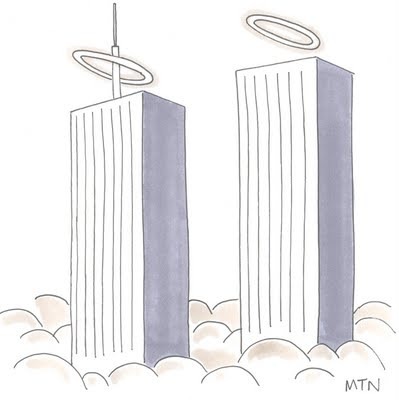Marc Tyler Nobleman's Blog, page 145
September 16, 2011
Super '70s and '80s: "Superman: The Movie"—Aaron Smolinski (Kal-El as a toddler)
Introduction to series "Super '70s and '80s."
Introduction to subseries "Superman: The Movie" (including list of interviewees).
[NOTE: Interview conducted 12/09. Special thanks to Jason Thomas for scanning and sending the images and to Aaron, of course, for providing them in the first place.]
How did you get cast in Superman: The Movie?
They had a big casting call and my aunt called my mom and told her about it. So down we went and waited in line. My brother was chosen first as the six-year-old (never made the cut) and I was the second choice for the part. On set, the first choice did not cooperate and I did, so they used me. They had to dye my hair because I was a blonde.
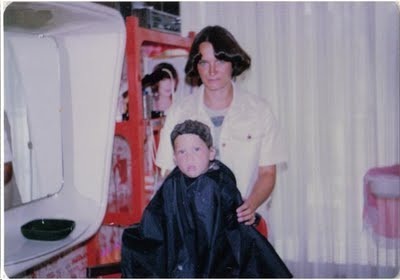
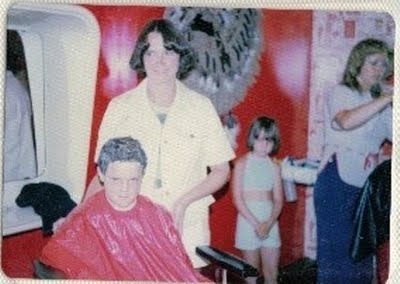
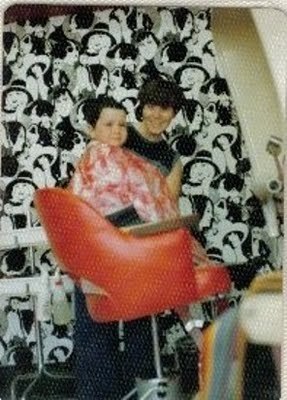
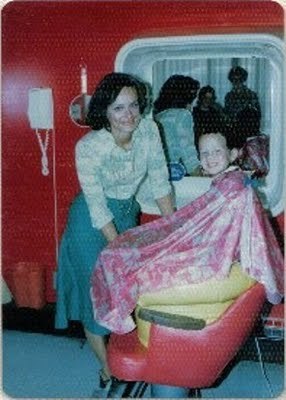 Was it the first movie you were in?
Was it the first movie you were in?
This was the first movie I was in.
What is your first memory of the whole experience?
I remember most of it, but I think my first memory is getting on the bus at the gas station to go to the location.
What else do you remember about filming your scenes?
I remember a lot. Richard Donner was great. He would wrap me in a blanket between takes, let me talk in his walkie-talkie, show me his trailer. I remember having lunch in the tent, hanging around in the "ship" as they were lighting. I remember my arms being soar from holding them up.
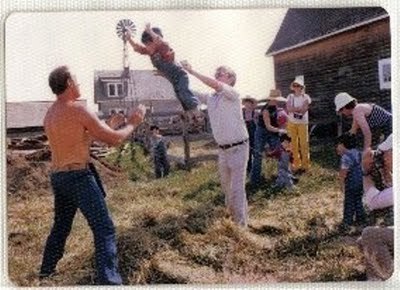
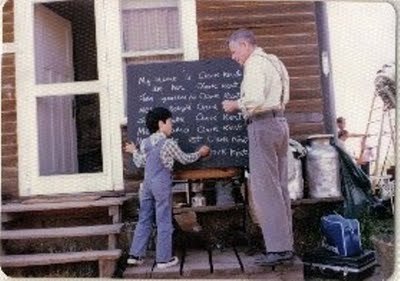
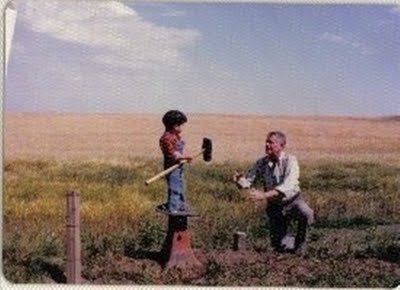
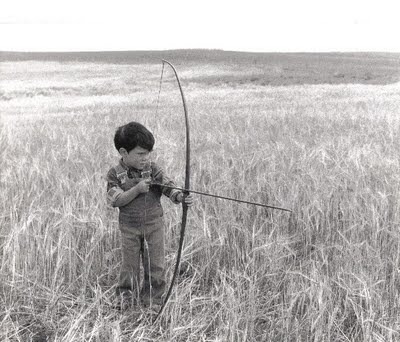
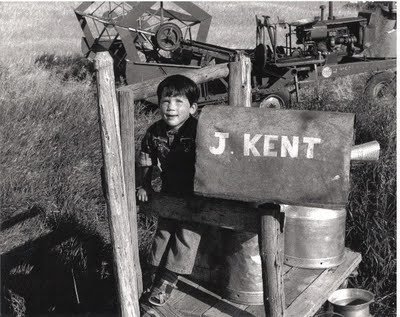 Where were your outdoor scenes shot?
Where were your outdoor scenes shot?
They were filmed in Blackie, Alberta, Canada.
Do you know how many days your shoot was?
It was about eight or nine days.
Do you know what your parents thought about you having to stand under the truck? Were they worried?
I think they were. My mum more than my dad. I think afterwards they were like "what were we thinking letting him stand under a truck?"
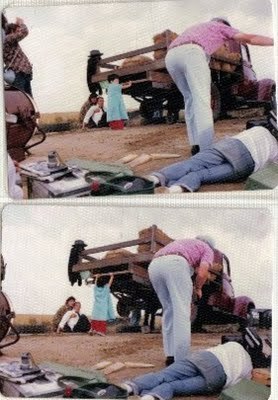
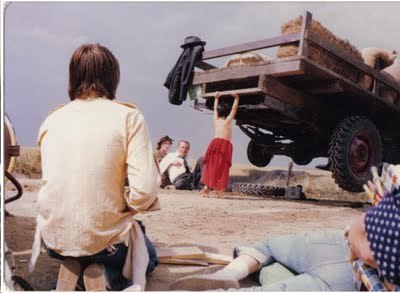 Do you remember what the filmmakers and/or your parents explained to you before shooting? Did you understand the story you were a part of?
Do you remember what the filmmakers and/or your parents explained to you before shooting? Did you understand the story you were a part of?
I don't remember them really explaining it. I remember just doing what I was told. And was happy to do it.
Do you have any "regular" anecdotes you've told friends over the years about filming STM?
Well, [they had to bargain with me] to come out of the capsule. I was shy and didn't really want to come out naked, so they had to bribe me. They first gave me a snow globe (which I still have). That didn't work so they asked what I wanted. I said a six-pack of Coke, so out that came. Then I still wasn't convinced so they asked again. "Juicy Fruit gum," I said. They obliged and here I came in my full glory.
There is also a blooper where Ma Kent says "He doesn't have any family" and then I say "Yes I do." That is why she ended up saying not around here anyway, because she went with it. Every time she said I didn't have any family, I kept saying [I did]; my mom and dad were there. She went with it but Mr. Ford wasn't so amused.
Since you were a boy when you filmed STM, did you get any special treatment on set? Or after? Lots of Superman action figures from Warner Bros., or anything like that?
The only special treatment I received was from Richard Donner and the cast and crew. Warner Bros. screwed me and gave me nothing (including residuals). But I am not bitter. In all fairness, Warner Bros. wasn't involved at that time (at least I don't think they were).
Have you ever approached them to renegotiate?
No, but may try.
Do you still have any props or other memorabilia (call sheets, correspondence, your contract, etc.) from the shoot?
I still have my contract (or lack thereof), the snow globe, and I am sure my mom has other stuff.
Do you know if your parents were instantly okay with your onscreen nudity? Today, of course, a superhero movie (or most any mainstream movie) would probably not show a naked child. What do you think about the way our cultural sensibility has changed in that regard?
Back then there wasn't as much cynicism as there is now. They were cautious, but not like people would be today. I mean, I was only three. I think our culture is overly sensitive, but you can never be too careful. Now when it airs on TV they don't show that part, which I am not sure why I haven't objected to it. You can go online and see those images or buy the movie, so…? I think if I was five or older, then I would agree, but I was basically a baby. To each his own. I do think that times are very different and we actually have to protect children now. They can't protect themselves. Not sure if this answers your question. I may respond more to this.
What if any disapproval have you personally heard about the fact that STM showed a boy naked?
The only disapproval I hear now is that they don't show it anymore. People, fans, say that was a big part of the scene and they think WB is being over protective.
Do you remember hearing what happened to the boy who played the baby in STM?
Lee Quigley, passed away. I never met him.
Do you remember if you liked Superman before you worked on the movie?
I don't think I really knew much about him.
Did you like him after?
I liked him, but wasn't obsessed.
Did you see the other movies?
I did see the other movies. They used the same scene for Superman II (which they didn't pay me for), and then I was in Superman III (kid at the photo booth. The lady who played my mom was my mom). I have seen them all.
Did you read Superman comics?
No.
Did you attend the STM premiere?
NO.
Lots of actors who've done superhero movies or shows go on to do voice-overs in superhero cartoons? Have you, or would you?
Haven't but would love to.
Did you ever correspond with anyone else from the cast of STM at any point?
I did speak with Richard Donner when I moved to LA.
Did you ever meet Christopher Reeve?
I met him during the filming of Superman III. The first thing I remember is shaking his hand and mine disappearing. He had such big hands (at least to an 8-year-old). He would also sit with me and all the extras and crew during lunch, which the other cast members wouldn't do. He was someone I looked up to. During my acting career, I was always loyal to my "fans" and never turned away from them. I am a firm believer that they are the reason actors can work and get paid for what they do. I think this came from my personality, but also from Christopher Reeve.
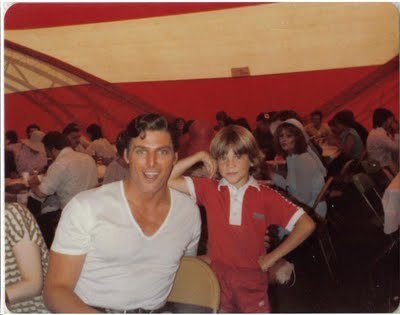
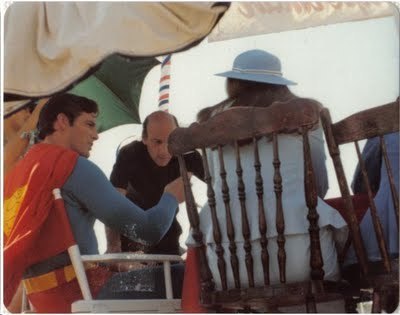 Were there ever any cast reunions?
Were there ever any cast reunions?
I think so, but I was never invited. I think WB was trying to keep me on the low knowing that they kinda took advantage of me and my family. That's a story on its own.
When/who else has interviewed you about STM? Were you ever interviewed on TV?
I think I did a radio interview during Superman III. I was never interviewed on TV.
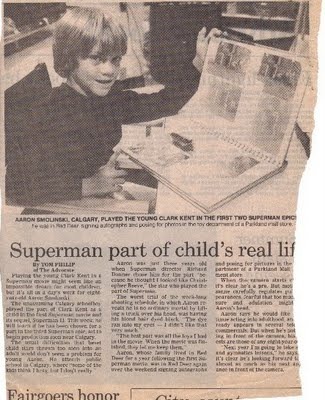
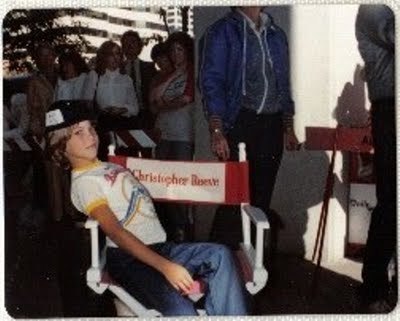 Have any strangers ever recognized you as the young boy from STM?
Have any strangers ever recognized you as the young boy from STM?
No…not without knowing that was me.
You're a father now. How old are your children? (Depending on that answer, have they seen you in STM? What do they think?)
My son is two and he has seen it. He is too young to really have an opinion, but thinks it is neat.
Most of the friends you've made in your life must have seen you in STM before you met them. Any funny stories about that?
They all make fun of the naked scene and say, "I hope things have changed…" To that I have a rebuttal…which I will keep to myself.
Did you see Superman Returns? Did you watch Smallville? If yes to either, what do you think?
Thought Superman Returns was better than I thought it would be. I didn't really watch Smallville.
The producers of Smallville often cast actors associated with past Superman or superhero TV shows. Were you approached?
[Actually], I was up for a part in the pilot—a friend of Clark's. Other than [that], I never auditioned [nor was I] approached. People told me all the time that I needed to get on it.
What do you do for a living now?
I am still plugging away, writing, acting, and hopefully producing a script I have. But the best job of all is being a husband and father.
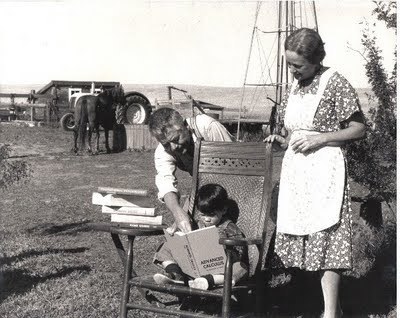 Next: Jeff East (Clark Kent as a teenager).
Next: Jeff East (Clark Kent as a teenager).

Introduction to subseries "Superman: The Movie" (including list of interviewees).
[NOTE: Interview conducted 12/09. Special thanks to Jason Thomas for scanning and sending the images and to Aaron, of course, for providing them in the first place.]
How did you get cast in Superman: The Movie?
They had a big casting call and my aunt called my mom and told her about it. So down we went and waited in line. My brother was chosen first as the six-year-old (never made the cut) and I was the second choice for the part. On set, the first choice did not cooperate and I did, so they used me. They had to dye my hair because I was a blonde.



 Was it the first movie you were in?
Was it the first movie you were in?This was the first movie I was in.
What is your first memory of the whole experience?
I remember most of it, but I think my first memory is getting on the bus at the gas station to go to the location.
What else do you remember about filming your scenes?
I remember a lot. Richard Donner was great. He would wrap me in a blanket between takes, let me talk in his walkie-talkie, show me his trailer. I remember having lunch in the tent, hanging around in the "ship" as they were lighting. I remember my arms being soar from holding them up.




 Where were your outdoor scenes shot?
Where were your outdoor scenes shot?They were filmed in Blackie, Alberta, Canada.
Do you know how many days your shoot was?
It was about eight or nine days.
Do you know what your parents thought about you having to stand under the truck? Were they worried?
I think they were. My mum more than my dad. I think afterwards they were like "what were we thinking letting him stand under a truck?"

 Do you remember what the filmmakers and/or your parents explained to you before shooting? Did you understand the story you were a part of?
Do you remember what the filmmakers and/or your parents explained to you before shooting? Did you understand the story you were a part of?I don't remember them really explaining it. I remember just doing what I was told. And was happy to do it.
Do you have any "regular" anecdotes you've told friends over the years about filming STM?
Well, [they had to bargain with me] to come out of the capsule. I was shy and didn't really want to come out naked, so they had to bribe me. They first gave me a snow globe (which I still have). That didn't work so they asked what I wanted. I said a six-pack of Coke, so out that came. Then I still wasn't convinced so they asked again. "Juicy Fruit gum," I said. They obliged and here I came in my full glory.
There is also a blooper where Ma Kent says "He doesn't have any family" and then I say "Yes I do." That is why she ended up saying not around here anyway, because she went with it. Every time she said I didn't have any family, I kept saying [I did]; my mom and dad were there. She went with it but Mr. Ford wasn't so amused.
Since you were a boy when you filmed STM, did you get any special treatment on set? Or after? Lots of Superman action figures from Warner Bros., or anything like that?
The only special treatment I received was from Richard Donner and the cast and crew. Warner Bros. screwed me and gave me nothing (including residuals). But I am not bitter. In all fairness, Warner Bros. wasn't involved at that time (at least I don't think they were).
Have you ever approached them to renegotiate?
No, but may try.
Do you still have any props or other memorabilia (call sheets, correspondence, your contract, etc.) from the shoot?
I still have my contract (or lack thereof), the snow globe, and I am sure my mom has other stuff.
Do you know if your parents were instantly okay with your onscreen nudity? Today, of course, a superhero movie (or most any mainstream movie) would probably not show a naked child. What do you think about the way our cultural sensibility has changed in that regard?
Back then there wasn't as much cynicism as there is now. They were cautious, but not like people would be today. I mean, I was only three. I think our culture is overly sensitive, but you can never be too careful. Now when it airs on TV they don't show that part, which I am not sure why I haven't objected to it. You can go online and see those images or buy the movie, so…? I think if I was five or older, then I would agree, but I was basically a baby. To each his own. I do think that times are very different and we actually have to protect children now. They can't protect themselves. Not sure if this answers your question. I may respond more to this.
What if any disapproval have you personally heard about the fact that STM showed a boy naked?
The only disapproval I hear now is that they don't show it anymore. People, fans, say that was a big part of the scene and they think WB is being over protective.
Do you remember hearing what happened to the boy who played the baby in STM?
Lee Quigley, passed away. I never met him.
Do you remember if you liked Superman before you worked on the movie?
I don't think I really knew much about him.
Did you like him after?
I liked him, but wasn't obsessed.
Did you see the other movies?
I did see the other movies. They used the same scene for Superman II (which they didn't pay me for), and then I was in Superman III (kid at the photo booth. The lady who played my mom was my mom). I have seen them all.
Did you read Superman comics?
No.
Did you attend the STM premiere?
NO.
Lots of actors who've done superhero movies or shows go on to do voice-overs in superhero cartoons? Have you, or would you?
Haven't but would love to.
Did you ever correspond with anyone else from the cast of STM at any point?
I did speak with Richard Donner when I moved to LA.
Did you ever meet Christopher Reeve?
I met him during the filming of Superman III. The first thing I remember is shaking his hand and mine disappearing. He had such big hands (at least to an 8-year-old). He would also sit with me and all the extras and crew during lunch, which the other cast members wouldn't do. He was someone I looked up to. During my acting career, I was always loyal to my "fans" and never turned away from them. I am a firm believer that they are the reason actors can work and get paid for what they do. I think this came from my personality, but also from Christopher Reeve.

 Were there ever any cast reunions?
Were there ever any cast reunions?I think so, but I was never invited. I think WB was trying to keep me on the low knowing that they kinda took advantage of me and my family. That's a story on its own.
When/who else has interviewed you about STM? Were you ever interviewed on TV?
I think I did a radio interview during Superman III. I was never interviewed on TV.

 Have any strangers ever recognized you as the young boy from STM?
Have any strangers ever recognized you as the young boy from STM?No…not without knowing that was me.
You're a father now. How old are your children? (Depending on that answer, have they seen you in STM? What do they think?)
My son is two and he has seen it. He is too young to really have an opinion, but thinks it is neat.
Most of the friends you've made in your life must have seen you in STM before you met them. Any funny stories about that?
They all make fun of the naked scene and say, "I hope things have changed…" To that I have a rebuttal…which I will keep to myself.
Did you see Superman Returns? Did you watch Smallville? If yes to either, what do you think?
Thought Superman Returns was better than I thought it would be. I didn't really watch Smallville.
The producers of Smallville often cast actors associated with past Superman or superhero TV shows. Were you approached?
[Actually], I was up for a part in the pilot—a friend of Clark's. Other than [that], I never auditioned [nor was I] approached. People told me all the time that I needed to get on it.
What do you do for a living now?
I am still plugging away, writing, acting, and hopefully producing a script I have. But the best job of all is being a husband and father.
 Next: Jeff East (Clark Kent as a teenager).
Next: Jeff East (Clark Kent as a teenager).
Published on September 16, 2011 04:24
September 15, 2011
Super '70s and '80s: "Superman: The Movie"—introduction
Introduction to series "Super '70s and '80s."
Actors interviewed (3 parts):
Aaron Smolinski (Kal-El as a toddler)
Jeff East (Clark Kent as a teenager)
Bo Rucker (pimp/fashion consultant)
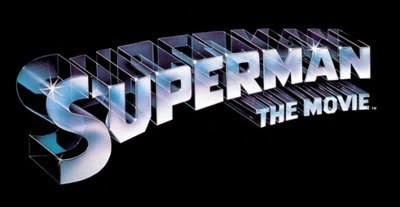 The fact that I still get a thrill from the 1978 movie was one of several reasons why I wanted to include it as a Super '70s and '80s subseries.
The fact that I still get a thrill from the 1978 movie was one of several reasons why I wanted to include it as a Super '70s and '80s subseries.
My book Boys of Steel: The Creators of Superman is about writer Jerry Siegel and artist Joe Shuster, who were just out of high school when they dreamed up the version of Superman that endures to this day.
But Aaron Smolinski and Jeff East are the cinematic Boys of Steel (and Aaron was the first person I interviewed for this entire series).
A YouTube poster called Bo Rucker's single line of dialogue "the most important moment in the Superman saga." Considering how many can quote it decades later, he may be on to something. (In case you are not one of them: "Say, Jim—whoa! That's a bad out-fit! Whoo!")
When I told Bo he has Superman fans who want to meet him at conventions, he was hugely skeptical because he spoke only one line in the movie. My friend Jamie Reigle is also a friend of Aaron Smolinski's; upon hearing Bo's comment, Jamie said people line up for Aaron…and his role had no lines!
I got permission to post all images from personal collections; if you want to repost, please do the same and ask me first.
Welcome to a look at the lesser-known history of Superman: The Movie.
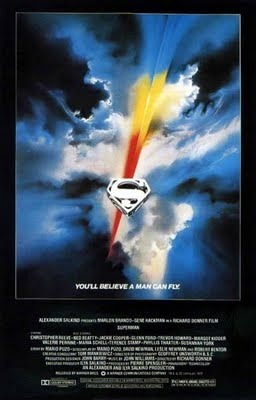
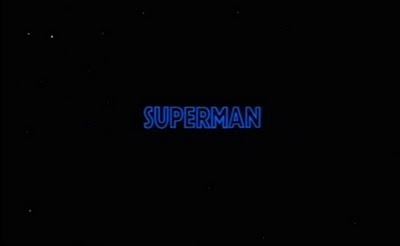 Some probably think they remember the logo appearing in the opening credits
Some probably think they remember the logo appearing in the opening credits
as it does at top of this post, but here is the actual screen grab.

Actors interviewed (3 parts):
Aaron Smolinski (Kal-El as a toddler)
Jeff East (Clark Kent as a teenager)
Bo Rucker (pimp/fashion consultant)
 The fact that I still get a thrill from the 1978 movie was one of several reasons why I wanted to include it as a Super '70s and '80s subseries.
The fact that I still get a thrill from the 1978 movie was one of several reasons why I wanted to include it as a Super '70s and '80s subseries.My book Boys of Steel: The Creators of Superman is about writer Jerry Siegel and artist Joe Shuster, who were just out of high school when they dreamed up the version of Superman that endures to this day.
But Aaron Smolinski and Jeff East are the cinematic Boys of Steel (and Aaron was the first person I interviewed for this entire series).
A YouTube poster called Bo Rucker's single line of dialogue "the most important moment in the Superman saga." Considering how many can quote it decades later, he may be on to something. (In case you are not one of them: "Say, Jim—whoa! That's a bad out-fit! Whoo!")
When I told Bo he has Superman fans who want to meet him at conventions, he was hugely skeptical because he spoke only one line in the movie. My friend Jamie Reigle is also a friend of Aaron Smolinski's; upon hearing Bo's comment, Jamie said people line up for Aaron…and his role had no lines!
I got permission to post all images from personal collections; if you want to repost, please do the same and ask me first.
Welcome to a look at the lesser-known history of Superman: The Movie.

 Some probably think they remember the logo appearing in the opening credits
Some probably think they remember the logo appearing in the opening creditsas it does at top of this post, but here is the actual screen grab.
Published on September 15, 2011 04:29
September 14, 2011
"A very welcome read"
It's been a long time since I've announced a new review of Boys of Steel: The Creators of Superman (which came out in 2008).
As such, I was pleasantly surprised last week to find one in a Google Alert, even more so when I saw that it is a particularly thoughtful and observant one, written by J. Caleb Mozzocco at the wonderfully named Every Day is Like Wednesday.
Mozzocco writes that the way I structured book is a "smart strategy." (More on this in a moment.) He calls the afterword "a nice, thorough summary." And he calls attention to a "rather remarkable four-page" sequence that relays Siegel and Shuster's 24-hour period of unfettered creation.
I enjoyed Mozzocco's astute observations about fair use of Superman and, in particular, about the fact that I ended this oft-told tragedy on a positive note, which is a courtesy the Boys of Steel so rarely get. Amid all the chatter about bad business decisions and big lawsuits, people forget that Siegel and Shuster also experienced moments of victory and stratospheric joy. Emphasizing that does not diminish the hardships; it only makes their struggle to overcome them all the more compelling.
Thanks, EDILW!
As such, I was pleasantly surprised last week to find one in a Google Alert, even more so when I saw that it is a particularly thoughtful and observant one, written by J. Caleb Mozzocco at the wonderfully named Every Day is Like Wednesday.
Mozzocco writes that the way I structured book is a "smart strategy." (More on this in a moment.) He calls the afterword "a nice, thorough summary." And he calls attention to a "rather remarkable four-page" sequence that relays Siegel and Shuster's 24-hour period of unfettered creation.
I enjoyed Mozzocco's astute observations about fair use of Superman and, in particular, about the fact that I ended this oft-told tragedy on a positive note, which is a courtesy the Boys of Steel so rarely get. Amid all the chatter about bad business decisions and big lawsuits, people forget that Siegel and Shuster also experienced moments of victory and stratospheric joy. Emphasizing that does not diminish the hardships; it only makes their struggle to overcome them all the more compelling.
Thanks, EDILW!
Published on September 14, 2011 04:17
September 13, 2011
Super '70s and '80s: Sea World superheroes water ski show—the skiers, part 10 of 10
Introduction to series "Super '70s and '80s."
Introduction to subseries "Sea World superheroes show" (including list of interviewees).
Skiers, part 9 of 10.
SWSH = Sea World superheroes
THE MEMORIES
Do you have any film footage of the SWSH show?
Andy Hansen: I might have a few Super 8 (no sound) shots my mom and dad took of my brother Roger and me.
Cindy Barhoff (Clasen): I did, but my husband taped over it (Ohio State/Michigan game). What's more important?
What other memorabilia, if any, did you save from the SWSH show (posters, programs/souvenir booklets, etc.)?
Linda Knapp (Moffett): I wish I had taken more pictures and that we could have had the technology back then that we have today. I have some photos and a few show programs in boxes in the attic. I also wish I had pictures taken with Sunja and me. She was a very neat animal and it is sometimes hard to convince people that I worked with a water skiing elephant.
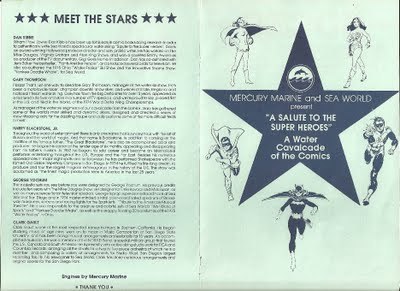 Odd that neither Superman and Batman (the most popular characters) nor
Odd that neither Superman and Batman (the most popular characters) nor
Aquaman (the unofficial star of this show) are on the cover of this program.
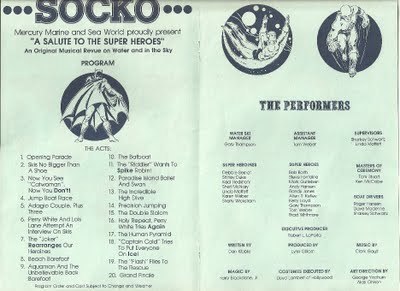 I managed to find and interview just about everybody listed here.
I managed to find and interview just about everybody listed here.
Randy Messer: I have the superhero ski show poster and I bet there aren't too many left.
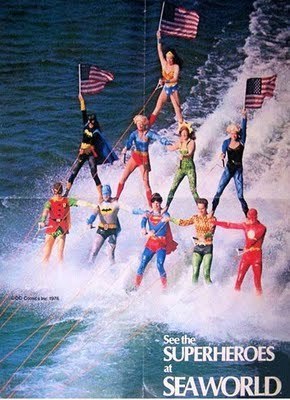 Jeff Parnell: Nothing. I was young and not thinking about tomorrow. My biggest regret is not having pictures to show my kids. I have often thought about asking Sea World if I could look thru their photo archives and get copies. Maybe that is something you might try. Have you done that already?
Jeff Parnell: Nothing. I was young and not thinking about tomorrow. My biggest regret is not having pictures to show my kids. I have often thought about asking Sea World if I could look thru their photo archives and get copies. Maybe that is something you might try. Have you done that already?
Andy Hansen: A few photos. Really not enough for all of the memories.
How do you look back at your time with the SWSH show?
Al Kelley: Great experience with several people that I really valued and would love to see again.
Betsy Maher (Hawkins): It was a blast! Staying in shape and getting paid to water ski. Meeting some very talented and wonderful friends.
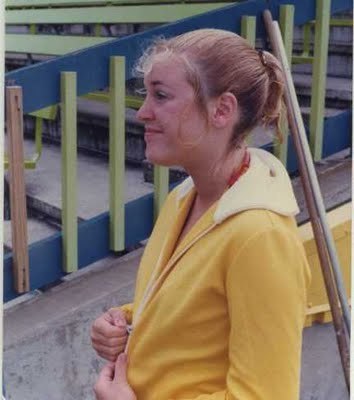
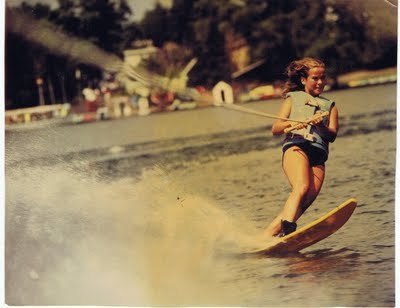
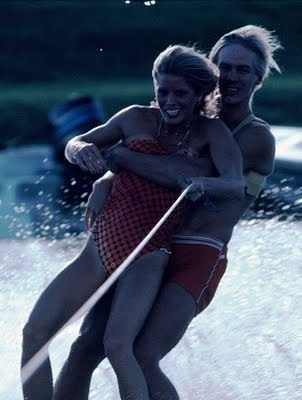 Bill Peterson: Was the break I was looking for to get into water skiing full time.
Bill Peterson: Was the break I was looking for to get into water skiing full time.
Bill Schwartz: One of the best times of my life. I was lucky to be able to be part of the Sea World water ski team. It was a great stepping stone in my life and the friendships there are deep and eternal.
Bubby Snow: They were the best times of my life.
Carl Lipsit: Great memories, lots of fun, good camaraderie, killer tan, and most importantly, I got paid to ski! How can you beat a gig like that, especially when still attending high school?
Cindy Barhoff (Clasen): One of the greatest memories in my life collection. I still share it with my class every year.
Dave Madeline: I'd do it again. Most everybody that you talk to would probably say they would do it again. It's such a good job for a young person. I think I wasted a good portion of my life there. I wasn't a doctor, I was a water skier. A lot of them went to college and did this on the side for the summer. It was a good way to get through college.
Diane Smith: I am old now and have lived a full and rewarding life. I have experienced numerous now-forgotten events, but I will forever remember those few years that I was a Sea World show skier. Hopefully, with [your] interviews, these memories will remain even when I am gone, as now, for the first time (thanks to your project), they are written and will be preserved and then shared with my children and their children. Thank you for collecting my remembrances and those of the outstanding athletes who were the superheroes of Sea World. It was the most special (and hardest) thing I ever did.
Gary Thompson: One of the best shows we ever did! It revolutionized ski shows forever. It was essentially the beginning of truly themed water ski shows that presented characters and told a story. Story-driven shows versus exhibition water skiing.
Greg Galloway: It was my favorite show of all the ones I skied in.
Janalee Zimmerman (Addleman): I loved it! It was the best memory to have made! My parents were nuts to let me do that at such a young age! But I'm glad they did! :-)
John Gillette: Great memories, fun time, rich relationships, some of which I maintain today.
Linda Knapp (Moffett): It played a large part of me growing up. I often wonder what happened to some of the skiers. It was a lot of hard work and was definitely a lesson on working as a team. I am really glad that I was able to ski professionally even though I am paying now with annoying body aches.
Mark Gutleben: It was fun skiing and playing around in the sun.
Mary McMurtrie: The best time of my life. An amazing opportunity with the most fun people I have ever met.
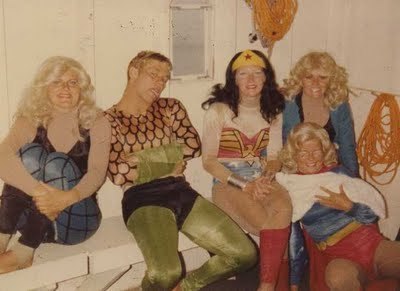 Nancy Radant Combes: Would not have traded it for anything.
Nancy Radant Combes: Would not have traded it for anything.
Paula Nelson (Bloemer): Since you have me reflecting, I think it probably was a great preparation for me later joining the circus (my favorite job ever). We were asked to learn a myriad of stunts and tricks and paid to do it. Before Nike's motto "Just Do It," water skiers had [the] motto "Go For It." Having come from an arts and dance background, I was rather confounded by their passion and intensity for the sport. But that is why they didn't mind the costumes—they were doing what they loved.
Randy Messer: For most of the skiers, I imagine the draw was the skiing with the superhero aspect secondary. I was an art major with my eye on becoming a comic strip artist like Charles Schulz (still has yet to happen) so for me, the combo of skiing and superheroes was a dream come true. I woke up every morning anxious to go to work. It was a dream of mine since the age of five (1958-59) when on vacation I saw a Cypress Gardens ski show. As a lad growing up in a small Iowa town I could not imagine a better job. When Sea World called to say I was hired, I had $200 dollars left to my name which was just enough to get me back to Iowa if nothing panned out in Florida. I rose through the ranks and loved almost every minute and would never have left were it not for having to choose between marrying Robbi or staying with Sea World. Fortunately I was hired by Marine World Africa USA to run their ski show. I always regretted leaving Sea World.
Shirley Duke: It started out as just a summer job between college, but if you'd observe your surroundings, it taught me a lot about corporate America, good leadership, hiring people with the right skills and talents, providing resources that allow your people to perform to the best of their abilities.
Steve Fontaine: Some of my most happy and carefree memories. Of course, I had no money then but I had fun anyway.
Suzanne Schwartz: With complete and utter fondness and nostalgia. We consider ourselves so lucky to have worked for Sea World (we both worked there for about 10 years) and to have been a part of the ski show. To be able to make a living (albeit meager) by performing with an incredible team of people was just a joy. Sharkey and I have the extra bonus of sharing those memories together...so we can still reflect on them together today.
Do you have a favorite memory about the SWSH show?
Al Kelley: Tom Weber not going up in the kite and the kite landing on the roof of the stadium; scary situation that was diverted due to the driving of Dave Madeline. Tom was attempting to fly in a hang glider that was attached to the boat that Dave was driving with a 1,000-foot rope. As the boat accelerates, the kite rises to about 700 feet then releases from the rope and the pilot free flies the hang glider onto the stage at the end of the show. Tom did not strap himself in on this flight so the kite went up by itself; thanks to quick thinking and driving, Dave was able to steer the hang glider away from the audience of about 3,000 people.
Christina Ashley: Meeting Dan Poor, a high diver in the show. We were a couple and really had a wonderful life together while we were at Sea World. We are still good friends today.
Cindy Barhoff (Clasen): Whenever the song "We Are Family" comes on the radio, I think of Sea World. We were together 24/7, and that was one of our warm-up songs.
Dave Madeline: There are so many good things. One year at Christmastime the superheroes pushed disabled kids around the park. I was a boat driver and dressed as the Penguin. We weren't skiing, just taking them to the whale shows and showing them different things. It was a big, big deal.
Diane Smith: I lived many miles from Sea World at the time and shortly after beginning there, I decided to be adventurous and I drove my Yamaha ("Today is the Day") motorcycle all the way to work. Part of the trip was via the "Bee Line" (now known as the "Beach Line," a major highway). I wore my required Sea World uniform and with my nearly knee-length, blonde hair, braided down my back and hanging from behind my helmet like a show-pony's tail, I arrived at the park without incident, though some of the guys with whom I worked advised that I should not repeat this as it was dangerous. I was proud that day since my adventure was new. When I entered the ski department, the female lead, Gay Peteet, said, "That is not all that you will be accomplishing for the first time today. You will also be going to the top of the pyramid as Supergirl." After those two new challenges, it became routine to ride my motorcycle to work and to perform as "top girl." Also, I especially remember my first day and my last one. Both times, I did not want the experience to end.
Doby Buesse: The night shows were a blast. I always thought they were better from a spectator viewpoint. The action is more focused because of the spotlights. Skiing in the dark was a thrill. With the bright spotlights you could only see the water directly in front of your skis. Made you feel like you were traveling faster than you really were.
Greg Galloway: The Penguin costume was awesome.
Jacque Cook (Kuntarich): It was the dream job. I wrote Gary Thompson to say thank you for giving me my best job of my whole life. After that, Dan Poor said the same thing. I had a kick-ass job (most recently) but Sea World was the coolest.
Jeff Parnell: When it was cold, if you sprayed another skier, that was war. John Macqueen sprayed me with the boat one day so after the show I clamped his fuel line on his boat so he had just enough fuel to get out to the set and drop off his skiers then he would run out and be a sitting duck. I'm not sure how many times I sprayed him but I remember how good it was. One show I was Robin and Greg Galloway was Batman. We got the kid in the boat and while the bad guys were chasing us Greg (Batman) was asking this poor kid about girls and beer. I was wondering what this kid was going to say to his parents when he got back to his seat. Well, we never heard from his parents or their attorney, so that was good. To this day I wonder what that kid thinks about Batman and Robin.
Kaci Whittenton (Hedstrum): All the laughter on land and water and special friends made.
Kerry Lloyd: Just being so healthy skiing. Still healthy now. I've hit golf balls every day for the past 11 years. There's a really good chance you'll see me playing a Senior Tour in golf.
Linda Knapp (Moffett): There's nothing quite like landing on the beach and hearing several thousand people applauding for you.
Lori Taylor: How terrible we all looked in the Supergirl wig.
Mark Gutleben: It was quite exciting to learn back barefoot.
Roland Hillier: The opportunity to go to the country of Jordan and teach the royal family and be the coach of the Royal Jordanian Ski Team.
Sherry Wickstrom: Yes: 1) meeting my first love, Dave; 2) taking measurements for the costumes, the magic acts, the elephant.
Steve Fontaine: Partying with my buddies and going to nickel night at Rosie O'Grady's. But nothing compares to the feeling you get when the fans goes wild.
Suzanne Schwartz: There are sooooooo many…I don't think there is one that stands out. Opening night of a new show…the funeral of "Flash" the goldfish…doing the Boca Raton road show…some of the antics in the locker room…
Could you guys get back in the water now and still do any of it?
Betsy Maher (Hawkins): Yes. Good idea for a reality show.
Al Kelley: Absolutely, although I wouldn't last as long…55 and not getting any younger!
Bill Peterson: Some of it. Probably many are too out of shape to do the more difficult acts.
Bill Schwartz: Yes, as a matter of fact a small group of us got together [the summer of 2009] and put on a small ski show here in Orlando. On [the small downtown] lake [where I live] is a small restaurant called Julie's Waterfront. Julie herself is a avid skier and has always catered to fellow skiers. She asked us to put on a ski show for her 25th anniversary. We quickly called in a few former Sea World skiers and incorporated them with our fellow lake skiers to put together a show ski team. Of the group of skiers who were in the superhero show were myself, Nancy Radant Combes, Mary McMurtrie, and Greg Galloway. We had children ages four to nine perform in the show as well. And the star was a skiing dog. The restaurant promoted the event and it was a full house of her regular guests, fellow lakefront owners, and friends of the skier families. The show was a big success and we decided to make it a annual event.
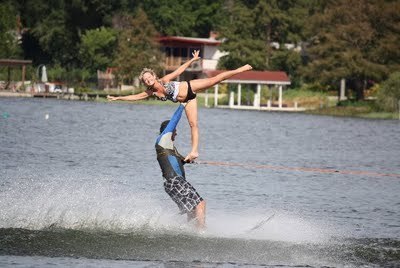
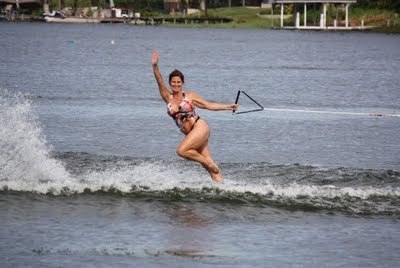 Cindy Barhoff (Clasen): I was only a summer employee, but the full time people could probably do it in their sleep.
Cindy Barhoff (Clasen): I was only a summer employee, but the full time people could probably do it in their sleep.
Diane Smith: Yes, but you must allow practicing with each other a bit before you watch! Skiing is a sport you and your muscles don't forget.
Gary Thompson: Some could.
Greg Galloway: Absolutely. Within the last year Nancy Combes and I did a doubles routine at a show with some old skiers.
Janalee Zimmerman (Addleman): YES! OF COURSE!
Jody Spence: Sure, some of it!
John Gillette: Most probably could do something, but not like we did.
Kaci Whittenton (Hedstrum): After a personal trainer has about a year to work with me!
Linda Knapp (Moffett): I like to think that I can, however we're not getting any younger!
Mary McMurtrie: ABSOLUTELY.
Nancy Radant Combes: Some of us put on a show in October 2009. So much fun!
Paula Nelson (Bloemer): I do not think I could, but I'm sure some of the others could.
Randy Messer: Can't speak for others but I could.
Roland Hillier: Not even a chance.
Sherry Wickstrom: Yes, with a couple of practices, no problem.
Shirley Duke: At the 10-year reunion nobody had changed; I bet we could've built a pyramid. Now maybe that's a little different. The "pilot light" is still flickering but you never know. As I said, I still have all my equipment.
Steve Fontaine: I'd like to think so!
Suzanne Schwartz: Sure! Errrr…some of it!
Andy Hansen: LOL! Sure. It wouldn't look quite the same, though.
Jeff Parnell: Sure, as long as someone pays the hospital or work comp bills.
Doby Buesse: I could do most of it but I would feel it the next day.
Carl Lipsit: Of course we could. Superheroes never age!
In Las Vegas in 2010, I was thrilled to be able to meet in person two of the skiers, Jody Spence and Reyna Blasko:
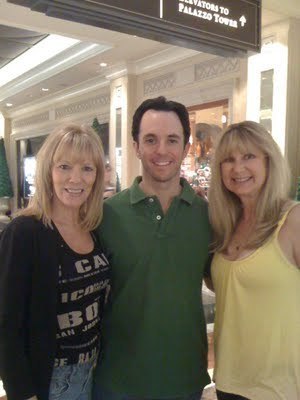 Next: Superman: The Movie.
Next: Superman: The Movie.

Introduction to subseries "Sea World superheroes show" (including list of interviewees).
Skiers, part 9 of 10.
SWSH = Sea World superheroes
THE MEMORIES
Do you have any film footage of the SWSH show?
Andy Hansen: I might have a few Super 8 (no sound) shots my mom and dad took of my brother Roger and me.
Cindy Barhoff (Clasen): I did, but my husband taped over it (Ohio State/Michigan game). What's more important?
What other memorabilia, if any, did you save from the SWSH show (posters, programs/souvenir booklets, etc.)?
Linda Knapp (Moffett): I wish I had taken more pictures and that we could have had the technology back then that we have today. I have some photos and a few show programs in boxes in the attic. I also wish I had pictures taken with Sunja and me. She was a very neat animal and it is sometimes hard to convince people that I worked with a water skiing elephant.
 Odd that neither Superman and Batman (the most popular characters) nor
Odd that neither Superman and Batman (the most popular characters) norAquaman (the unofficial star of this show) are on the cover of this program.
 I managed to find and interview just about everybody listed here.
I managed to find and interview just about everybody listed here.Randy Messer: I have the superhero ski show poster and I bet there aren't too many left.
 Jeff Parnell: Nothing. I was young and not thinking about tomorrow. My biggest regret is not having pictures to show my kids. I have often thought about asking Sea World if I could look thru their photo archives and get copies. Maybe that is something you might try. Have you done that already?
Jeff Parnell: Nothing. I was young and not thinking about tomorrow. My biggest regret is not having pictures to show my kids. I have often thought about asking Sea World if I could look thru their photo archives and get copies. Maybe that is something you might try. Have you done that already?Andy Hansen: A few photos. Really not enough for all of the memories.
How do you look back at your time with the SWSH show?
Al Kelley: Great experience with several people that I really valued and would love to see again.
Betsy Maher (Hawkins): It was a blast! Staying in shape and getting paid to water ski. Meeting some very talented and wonderful friends.


 Bill Peterson: Was the break I was looking for to get into water skiing full time.
Bill Peterson: Was the break I was looking for to get into water skiing full time.Bill Schwartz: One of the best times of my life. I was lucky to be able to be part of the Sea World water ski team. It was a great stepping stone in my life and the friendships there are deep and eternal.
Bubby Snow: They were the best times of my life.
Carl Lipsit: Great memories, lots of fun, good camaraderie, killer tan, and most importantly, I got paid to ski! How can you beat a gig like that, especially when still attending high school?
Cindy Barhoff (Clasen): One of the greatest memories in my life collection. I still share it with my class every year.
Dave Madeline: I'd do it again. Most everybody that you talk to would probably say they would do it again. It's such a good job for a young person. I think I wasted a good portion of my life there. I wasn't a doctor, I was a water skier. A lot of them went to college and did this on the side for the summer. It was a good way to get through college.
Diane Smith: I am old now and have lived a full and rewarding life. I have experienced numerous now-forgotten events, but I will forever remember those few years that I was a Sea World show skier. Hopefully, with [your] interviews, these memories will remain even when I am gone, as now, for the first time (thanks to your project), they are written and will be preserved and then shared with my children and their children. Thank you for collecting my remembrances and those of the outstanding athletes who were the superheroes of Sea World. It was the most special (and hardest) thing I ever did.
Gary Thompson: One of the best shows we ever did! It revolutionized ski shows forever. It was essentially the beginning of truly themed water ski shows that presented characters and told a story. Story-driven shows versus exhibition water skiing.
Greg Galloway: It was my favorite show of all the ones I skied in.
Janalee Zimmerman (Addleman): I loved it! It was the best memory to have made! My parents were nuts to let me do that at such a young age! But I'm glad they did! :-)
John Gillette: Great memories, fun time, rich relationships, some of which I maintain today.
Linda Knapp (Moffett): It played a large part of me growing up. I often wonder what happened to some of the skiers. It was a lot of hard work and was definitely a lesson on working as a team. I am really glad that I was able to ski professionally even though I am paying now with annoying body aches.
Mark Gutleben: It was fun skiing and playing around in the sun.
Mary McMurtrie: The best time of my life. An amazing opportunity with the most fun people I have ever met.
 Nancy Radant Combes: Would not have traded it for anything.
Nancy Radant Combes: Would not have traded it for anything.Paula Nelson (Bloemer): Since you have me reflecting, I think it probably was a great preparation for me later joining the circus (my favorite job ever). We were asked to learn a myriad of stunts and tricks and paid to do it. Before Nike's motto "Just Do It," water skiers had [the] motto "Go For It." Having come from an arts and dance background, I was rather confounded by their passion and intensity for the sport. But that is why they didn't mind the costumes—they were doing what they loved.
Randy Messer: For most of the skiers, I imagine the draw was the skiing with the superhero aspect secondary. I was an art major with my eye on becoming a comic strip artist like Charles Schulz (still has yet to happen) so for me, the combo of skiing and superheroes was a dream come true. I woke up every morning anxious to go to work. It was a dream of mine since the age of five (1958-59) when on vacation I saw a Cypress Gardens ski show. As a lad growing up in a small Iowa town I could not imagine a better job. When Sea World called to say I was hired, I had $200 dollars left to my name which was just enough to get me back to Iowa if nothing panned out in Florida. I rose through the ranks and loved almost every minute and would never have left were it not for having to choose between marrying Robbi or staying with Sea World. Fortunately I was hired by Marine World Africa USA to run their ski show. I always regretted leaving Sea World.
Shirley Duke: It started out as just a summer job between college, but if you'd observe your surroundings, it taught me a lot about corporate America, good leadership, hiring people with the right skills and talents, providing resources that allow your people to perform to the best of their abilities.
Steve Fontaine: Some of my most happy and carefree memories. Of course, I had no money then but I had fun anyway.
Suzanne Schwartz: With complete and utter fondness and nostalgia. We consider ourselves so lucky to have worked for Sea World (we both worked there for about 10 years) and to have been a part of the ski show. To be able to make a living (albeit meager) by performing with an incredible team of people was just a joy. Sharkey and I have the extra bonus of sharing those memories together...so we can still reflect on them together today.
Do you have a favorite memory about the SWSH show?
Al Kelley: Tom Weber not going up in the kite and the kite landing on the roof of the stadium; scary situation that was diverted due to the driving of Dave Madeline. Tom was attempting to fly in a hang glider that was attached to the boat that Dave was driving with a 1,000-foot rope. As the boat accelerates, the kite rises to about 700 feet then releases from the rope and the pilot free flies the hang glider onto the stage at the end of the show. Tom did not strap himself in on this flight so the kite went up by itself; thanks to quick thinking and driving, Dave was able to steer the hang glider away from the audience of about 3,000 people.
Christina Ashley: Meeting Dan Poor, a high diver in the show. We were a couple and really had a wonderful life together while we were at Sea World. We are still good friends today.
Cindy Barhoff (Clasen): Whenever the song "We Are Family" comes on the radio, I think of Sea World. We were together 24/7, and that was one of our warm-up songs.
Dave Madeline: There are so many good things. One year at Christmastime the superheroes pushed disabled kids around the park. I was a boat driver and dressed as the Penguin. We weren't skiing, just taking them to the whale shows and showing them different things. It was a big, big deal.
Diane Smith: I lived many miles from Sea World at the time and shortly after beginning there, I decided to be adventurous and I drove my Yamaha ("Today is the Day") motorcycle all the way to work. Part of the trip was via the "Bee Line" (now known as the "Beach Line," a major highway). I wore my required Sea World uniform and with my nearly knee-length, blonde hair, braided down my back and hanging from behind my helmet like a show-pony's tail, I arrived at the park without incident, though some of the guys with whom I worked advised that I should not repeat this as it was dangerous. I was proud that day since my adventure was new. When I entered the ski department, the female lead, Gay Peteet, said, "That is not all that you will be accomplishing for the first time today. You will also be going to the top of the pyramid as Supergirl." After those two new challenges, it became routine to ride my motorcycle to work and to perform as "top girl." Also, I especially remember my first day and my last one. Both times, I did not want the experience to end.
Doby Buesse: The night shows were a blast. I always thought they were better from a spectator viewpoint. The action is more focused because of the spotlights. Skiing in the dark was a thrill. With the bright spotlights you could only see the water directly in front of your skis. Made you feel like you were traveling faster than you really were.
Greg Galloway: The Penguin costume was awesome.
Jacque Cook (Kuntarich): It was the dream job. I wrote Gary Thompson to say thank you for giving me my best job of my whole life. After that, Dan Poor said the same thing. I had a kick-ass job (most recently) but Sea World was the coolest.
Jeff Parnell: When it was cold, if you sprayed another skier, that was war. John Macqueen sprayed me with the boat one day so after the show I clamped his fuel line on his boat so he had just enough fuel to get out to the set and drop off his skiers then he would run out and be a sitting duck. I'm not sure how many times I sprayed him but I remember how good it was. One show I was Robin and Greg Galloway was Batman. We got the kid in the boat and while the bad guys were chasing us Greg (Batman) was asking this poor kid about girls and beer. I was wondering what this kid was going to say to his parents when he got back to his seat. Well, we never heard from his parents or their attorney, so that was good. To this day I wonder what that kid thinks about Batman and Robin.
Kaci Whittenton (Hedstrum): All the laughter on land and water and special friends made.
Kerry Lloyd: Just being so healthy skiing. Still healthy now. I've hit golf balls every day for the past 11 years. There's a really good chance you'll see me playing a Senior Tour in golf.
Linda Knapp (Moffett): There's nothing quite like landing on the beach and hearing several thousand people applauding for you.
Lori Taylor: How terrible we all looked in the Supergirl wig.
Mark Gutleben: It was quite exciting to learn back barefoot.
Roland Hillier: The opportunity to go to the country of Jordan and teach the royal family and be the coach of the Royal Jordanian Ski Team.
Sherry Wickstrom: Yes: 1) meeting my first love, Dave; 2) taking measurements for the costumes, the magic acts, the elephant.
Steve Fontaine: Partying with my buddies and going to nickel night at Rosie O'Grady's. But nothing compares to the feeling you get when the fans goes wild.
Suzanne Schwartz: There are sooooooo many…I don't think there is one that stands out. Opening night of a new show…the funeral of "Flash" the goldfish…doing the Boca Raton road show…some of the antics in the locker room…
Could you guys get back in the water now and still do any of it?
Betsy Maher (Hawkins): Yes. Good idea for a reality show.
Al Kelley: Absolutely, although I wouldn't last as long…55 and not getting any younger!
Bill Peterson: Some of it. Probably many are too out of shape to do the more difficult acts.
Bill Schwartz: Yes, as a matter of fact a small group of us got together [the summer of 2009] and put on a small ski show here in Orlando. On [the small downtown] lake [where I live] is a small restaurant called Julie's Waterfront. Julie herself is a avid skier and has always catered to fellow skiers. She asked us to put on a ski show for her 25th anniversary. We quickly called in a few former Sea World skiers and incorporated them with our fellow lake skiers to put together a show ski team. Of the group of skiers who were in the superhero show were myself, Nancy Radant Combes, Mary McMurtrie, and Greg Galloway. We had children ages four to nine perform in the show as well. And the star was a skiing dog. The restaurant promoted the event and it was a full house of her regular guests, fellow lakefront owners, and friends of the skier families. The show was a big success and we decided to make it a annual event.

 Cindy Barhoff (Clasen): I was only a summer employee, but the full time people could probably do it in their sleep.
Cindy Barhoff (Clasen): I was only a summer employee, but the full time people could probably do it in their sleep.Diane Smith: Yes, but you must allow practicing with each other a bit before you watch! Skiing is a sport you and your muscles don't forget.
Gary Thompson: Some could.
Greg Galloway: Absolutely. Within the last year Nancy Combes and I did a doubles routine at a show with some old skiers.
Janalee Zimmerman (Addleman): YES! OF COURSE!
Jody Spence: Sure, some of it!
John Gillette: Most probably could do something, but not like we did.
Kaci Whittenton (Hedstrum): After a personal trainer has about a year to work with me!
Linda Knapp (Moffett): I like to think that I can, however we're not getting any younger!
Mary McMurtrie: ABSOLUTELY.
Nancy Radant Combes: Some of us put on a show in October 2009. So much fun!
Paula Nelson (Bloemer): I do not think I could, but I'm sure some of the others could.
Randy Messer: Can't speak for others but I could.
Roland Hillier: Not even a chance.
Sherry Wickstrom: Yes, with a couple of practices, no problem.
Shirley Duke: At the 10-year reunion nobody had changed; I bet we could've built a pyramid. Now maybe that's a little different. The "pilot light" is still flickering but you never know. As I said, I still have all my equipment.
Steve Fontaine: I'd like to think so!
Suzanne Schwartz: Sure! Errrr…some of it!
Andy Hansen: LOL! Sure. It wouldn't look quite the same, though.
Jeff Parnell: Sure, as long as someone pays the hospital or work comp bills.
Doby Buesse: I could do most of it but I would feel it the next day.
Carl Lipsit: Of course we could. Superheroes never age!
In Las Vegas in 2010, I was thrilled to be able to meet in person two of the skiers, Jody Spence and Reyna Blasko:
 Next: Superman: The Movie.
Next: Superman: The Movie.
Published on September 13, 2011 04:25
September 12, 2011
Super '70s and '80s: Sea World superheroes water ski show—the skiers, part 9 of 10
Introduction to series "Super '70s and '80s."
Introduction to subseries "Sea World superheroes show" (including list of interviewees).
Skiers, part 8 of 10.
SWSH = Sea World superheroes
YOUR LIFE TODAY
What do you do for a living?
Al Kelley: Senior Director, Marine Mammal Operations.
Andy Hansen: Wakeboard Camp [a water ski/wakeboard school he started].
Bill Peterson: Retired.
Bill Schwartz: Property manager/real-estate investor and father.
Bubby Snow: I run Bubby's Water Shows. Taught water skiing.
Carl Lipsit: I was in the Army for 26 years and retired as a Colonel in 2008. I now work for a firm as a Vice President with responsibilities for the international operations of the company as well as the contracting staff personnel. The company is heavily involved in biometrics, forensics, identity management, and advanced armoring systems (vehicle and personal), and we provide scientists and engineers working on a variety of issues.
Christina Ashley: Real estate broker.
Cindy Barhoff (Clasen): 4th grade teacher.
Dave Madeline: Jeweler. Goldsmith.
Diane Smith: I am a retired teacher and Professor of English who taught all grades from elementary through college-level.
Doby Buesse: UPS driver.
Gary Thompson: Produce and operate ski shows and live action stunt shows.
Greg Galloway: I own my own money management firm.
Jacque Cook (Kuntarich): I had a brain aneurysm May 6, 2009. It was because of water skiing. I had to retire from my job; I was a make-up and hair artist [for everyone] from the president (I had secret service clearance at the White House) to hip hop artists. I was Johnny Cochran's makeup artist, John Travolta, Gloria Estefan made me my first Mojito. I was always on a plane. I was home only 5-7 days a month. I've won a couple Emmys. I worked on the Witness Relocation Program.
There was a women's reunion after my aneurysm. When John Macqueen heard about the women reunion, he said I'm going to throw a party and say it's my birthday but it was really just a chance to get together. You [might] think, [they're] just ski bums, but everyone is very successful and many are multimillionaires.
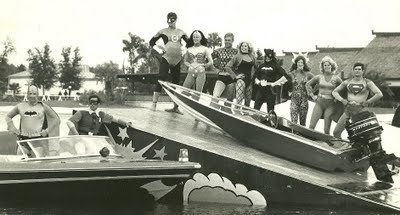 Janalee Zimmerman (Addleman): I graduated from college and got hired by the Somerset School District and I've been teaching there ever since. I've been teaching first grade for 29 years.
Janalee Zimmerman (Addleman): I graduated from college and got hired by the Somerset School District and I've been teaching there ever since. I've been teaching first grade for 29 years.
Jeff Parnell: Real estate.
Jody Spence: Manage a department at a timeshare company since 1994 in Florida, and then they transferred me to Vegas.
John Gillette: Operations manager.
Kaci Whittenton (Hedstrum): I am a petroleum landman, which is a independent contractor who in my case runs title for projects for oil and gas exploration.
Kerry Lloyd: Teach hang gliding. I'm [also] a pilot.
Linda Knapp (Moffett): I just retired from teaching. I taught second and fourth grades and most recently sixth-grade English. I told my students about skiing and being a professional athlete; however, they couldn't really relate. Some of them were under the impression that they would go straight to the NBA after high school (with no desire to practice, of course). It's hard for them to visualize a ski show since they pretty much don't exist anymore and there aren't any in Virginia. As far as the superheroes, it would be very difficult to explain that. A lot of adults have never seen a show.
Lori Taylor: Mow grass and manage a rental property.
Margie LaPoint (Bates): I teach kindergarten. A great age to relive Batman, Spider-Man, etc., at Halloween!
Mark Gutleben: Not much. Collecting social security and disability.
Mary McMurtrie: Massage therapist and unit secretary for a hospital.
Nancy Radant Combes: Special ed teacher.
Paula Nelson (Bloemer): I am a substitute teacher.
Randy Messer: Programmer.
Reyna Blasko: Wine specialist.
Roland Hillier: Own real estate rental properties and have taught science at Union Park Middle School since 1983.
Sherry Wickstrom: Transportation Security Officer (TSA) Homeland Security.
Shirley Duke: I am an Equal Rights Officer with FEMA. I am a Florida Supreme Court Certified Mediator and I was a volunteer mediator with the 9th Judicial Court in Orlando. I used a picture of me as Wonder Woman during one of our "Guess The Mediator" quizzes when they recognize several mediators at the end of the year.
Steve Fontaine: I am an irrigation contractor.
Suzanne Schwartz: I've worked in sales operations for a high-tech company based in Silicon Valley for the past ten years. I'm fortunate to be able to work from home. Sharkey recently left the large construction company he was working for (doing tool repair and general maintenance).
Tom Weber: Work for a publishing company.
Do you still water ski?
Al Kelley: It's been about 10 years.
Bill Schwartz: Yes. After Sea World I began competing in three-event water skiing (slalom, trick, and jumping). I went on to win many titles and championships in State, Regional, and National competitions. I won the 1997 nation overall title. I have not competed the last few years but do ski on a regular basis. I plan to compete [again].
Carl Lipsit: Whenever I get a chance! Normally, only when I get down to Florida and visit friends.
Dave Madeline: In the last few years, I've been lucky to get out once per summer. Now I have a boat and I'm restoring it. I'll use it to ski more, start teaching my grandkids, nephews, nieces.
Doby Buesse: Yes, I wally around on the slalom and wakeboard.
Janalee Zimmerman (Addleman): Yes. We still have a lot on Lake Stonycreek. I barefooted for my 50th birthday! Not very far though! LOL.
Kaci Whittenton (Hedstrum): No. Busy busy busy.
Kerry Lloyd: No, haven't since 1997, at Holiday Park in Germany. I was the show director that year. It's the hardest place in the world to water ski—way small, way tight, way dangerous. It's only for the big dogs. So I did it once just to do it, and then I was done and haven't skied since.
Margie LaPoint (Bates): I have nothing to do with water skiing anymore. I snow ski (Nordic) and ski race. I have raced my bicycle for many years since my water ski days, and now that I am older I run in races to complement my snow ski racing. I love living and playing and still think, feel, and look young.
Mark Gutleben: Oh yeah!
Randy Messer: Live on a lake and water ski occasionally. Can still perform most tricks. Several other former show skiers also live or have lived on the lake. It is our kids that use up the gas now.
Shirley Duke: No, I retired from competitive water skiing in 1996. But I still have my skies, wetsuits, medals, and memories.
Suzanne Schwartz: Up until two summers ago, our summers were still spent at the same lake that Sharkey grew up on. However, the Bureau of Reclamation chose not to renew the leases to the resorts on that lake and closed everything down. It's too much of a hassle to get your boat launched (basically one ramp for the entire lake) so we've not been. We are probably going to sell the ski boat.
If not, do you still have a presence on the water somehow (swimming, scuba, boating, fishing, etc.)?
Christina Ashley: Yes, I am a water baby. I live on the water, sell waterfront properties, fish, swim, boat, scuba.
Doby Buesse: Most definitely. Surfing, scuba, wind surfing, lying in the boat reading the Sunday paper or drinking a cold beer.
Gary Thompson: Yes…we are very high profile on the water, always attracting attention.
Jody Spence: No, not water. I have been a horse girl all my life, so I do a lot of riding.
Linda Knapp (Moffett): We own 74 acres with an 11-acre lake on the property. We still enjoy water sports and have jet skis, a rope swing, canoes, etc. During the summer we are on the lake a lot.
Randy Messer: Windsurfers were brand new back in late '70s. Windsurfing became my favorite activity for many years and I still get out regularly. I never wanted to leave show skiing and have worked out for the past 20 years building strength and maintaining fitness in the slim hope that one day I may perform again. I am 57 and am in better shape than when I skied in my twenties and thirties.
Roland Hillier: Designated driver for my grandkids.
Shirley Duke: My husband and I sold our Hydrodyne and took up kayaking. I love being on the water. We have two horses who also love to be in the lake. We've been married for 44 years. Water skiing was our first date.
Steve Fontaine: I'm in the water every day at work. I also kayak.
Do you have children and, if so, how old are they?
Al Kelley: Three grown children four grandchildren.
Andy Hansen: 24, 22, and 19.
Bill Peterson: Kyle is 35 and daughter Kaci is 30; she was named after a fellow skier, Kaci Hedstrum.
Bill Schwartz: 17-year-old daughter.
Bubby Snow: Daughter 28, son 24.
Carl Lipsit: One boy and one girl, ages 11 and 5.
Christina Ashley: I have three boys, Charles 26, Christopher 22, and Wilson 20. Their last name is Nock.
Cindy Barhoff (Clasen): 25, 23, and 20.
Dave Madeline: One girl, schoolteacher, Emily, Maryland near Annapolis; one grandson.
Diane Smith: I am blessed with two wonderful daughters. The older is 27, a graduate of UPenn Dental School, and currently at the University of Michigan completing her orthodontic residency. The younger is a graduate of Princeton University who is currently in her second year at Emory Law School.
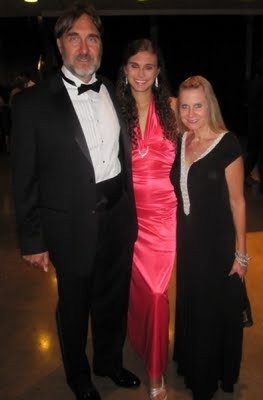
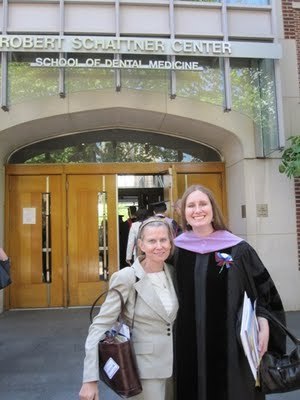 Gary Thompson: Two daughters and five grandchildren.
Gary Thompson: Two daughters and five grandchildren.
Greg Galloway: Two boys, Clark, 18, and Drew, 17.
Jacque Cook (Kuntarich): Son 21, daughter 18.
Janalee Zimmerman (Addleman): We have four children. Katie is 25 and teaches at North Star Elementary School nearby. Sam, 20, is a sophomore at Duke. Lastly we have twin sons, Joe and Jordan, 18.
Jeff Parnell: 2, 7, and 9.
Jody Spence: 27 and 25.
John Gillette: 15, 21, and 22.
Kaci Whittenton (Hedstrum): Meegan, 26.
Kerry Lloyd: Two wonderful children, 27 and twins. Boy and girl. Daughter married now for going on four years. I got three grandchildren. She doesn't go to the hospital to have babies. Has them at home in the bathtub. Got in on video. She lives in Windemere, part of Orlando. My son has got his credentials for being a minister. He's a manager of a Chick-fil-A and has been with them since high school. He's a musician—way, way good. Plays with that group Between the Trees that were #3 on Billboard charts. He lives in Orlando.
Linda Knapp (Moffett): One daughter, Katie, who is married and built a house on our property. She is 28 and is a chemist. Her husband is from the Czech Republic and is a police officer.
Lori Taylor: 26 and 22.
Margie LaPoint (Bates): I have two daughters, 23 and 24.
Mark Gutleben: No, too bad. Never been married.
Mary McMurtrie: Daughters 29, 28, and 23.
Nancy Radant Combes: Two girls, 18 and 22.
Paula Nelson (Bloemer): Two daughters. One is 24 and one is 20.
Randy Messer: Daughter 18, son 16.
Reyna Blasko: 27 and 28.
Roland Hillier: Three your age (mid- to late-30s). Six grandchildren.
Sherry Wickstrom: A son, 26 years old.
Shirley Duke: One daughter (27) and two sons (25 and 23). I have a granddaughter who is four years old (I'm a young grammy).
Steve Fontaine: I have a daughter who is 21 from my first marriage.
Suzanne Schwartz: Son Ryan is 31 and daughter Afton is 27.
Tom Weber: Five ranging from 30 to 16.
Do your kids water ski?
Al Kelley: Not yet but I plan on teaching them.
Andy Hansen: World Champion wakeboarders, wakeskaters.
Bill Peterson: They both water ski and snowboard. Both water skiied competitively, Kaci up to the National level. Kyle won the Junior World Championship overall and Junior Masters Overall; he was World Trick Ski Champ when he was 21. Now both just ski for fun—Kyle lives in Denver and snowboards mostly for fun.
Bubby Snow: Both professionally.
Carl Lipsit: Unfortunately no. They have not had the opportunity to learn. However, they do snow ski.
Christina Ashley: They all do; not professionally.
Gary Thompson: They all ski. It is required. My daughters were both Sea World skiers in San Diego.
John Gillette: Dad's requirement, like it or not!
Linda Knapp (Moffett): Katie skied when she was two and was slaloming by 5. She skis occasionally.
Mary McMurtrie: They all water ski, none with passion though.
What do your kids think of your time as a water skiing superhero?
Andy Hansen: LOL. They don't ask much about it. I don't talk about it with them.
Bill Peterson: Kyle remembers it vaguely; they both hear the stories and think it was pretty cool.
Bill Schwartz: My daughter just calls me a big kid.
Carl Lipsit: They think it is funny. I think they would love to perform in the acts where you get to jump boats and jet skis off the ramps.
Diane Smith: Of course they are proud that "old mom" was able to be a show skier at Sea World. It was their favorite theme park [when they were young] and when we would watch the ski show, I would narrate to them what was happening behind the scenes. I always watched in awe, hardly believing that I used to do all those stunts.
Jacque Cook (Kuntarich): When they grew up, it was like a normal lifestyle for them. I was out of the house at 17. By the time I was 19 I was a world champion. I was also going to college full time. I was the only girl to do that. Some of the guys did. After the superheroes show, some of the girls did.
Janalee Zimmerman (Addleman): They are impressed, however they also think it's funny! You know teenagers! Moms are never cool!
Kerry Lloyd: They don't even know. They've seen pictures. They've seen me in entertainment for so many years it's just another character. At Dixie Stampede in Tennessee, when my kids were ten, they did a special holiday show for six weeks built around them, my kids were so cute. My kids were in it—two little characters traveling across America in the 1800s on a wagon train. We home schooled. They traveled with me all over the country.
Linda Knapp (Moffett): It's hard to say since that was way before she was born and it was just a job.
Mary McMurtrie: That we were awesome.
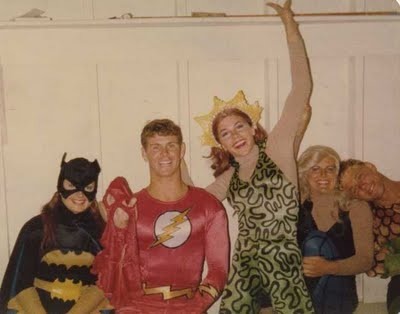 Nancy Radant Combes: They think it was an awesome experience. One of them wears my old ski sweatshirt even at college.
Nancy Radant Combes: They think it was an awesome experience. One of them wears my old ski sweatshirt even at college.
Paula Nelson (Bloemer): Since I was also an elephant-riding circus performer, they just think it was another peculiar occupation that I had B.C. (before children). My older daughter Jenna, an artist and vintage clothing re-designer, has a picture of me as Wonder Woman jumping a boat on display at her shop so I suppose she thinks it was pretty cool. The shop is called Sickboy Vintage in Tallahassee.
Randy Messer: Just recently found a tape of a superhero night show. Quality is marginal but watched it with son who thought it was kind of impressive.
Reyna Blasko: They laugh.
Sherry Wickstrom: He is more impressed with my skiing at Cypress Gardens. He saw an old-timers show I skied in.
Have you been interviewed before about the SWSH show?
Cindy Barhoff (Clasen): The Cleveland Plain Dealer did an article about interesting summer jobs.
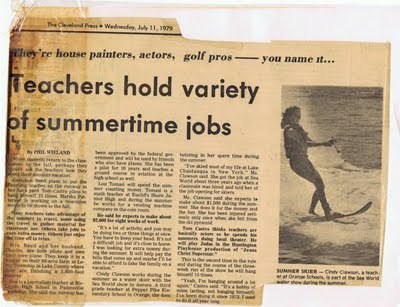 Reyna Blasko: I was Wonder Woman in an article for the armed services, I think. It has been so long.
Reyna Blasko: I was Wonder Woman in an article for the armed services, I think. It has been so long.
What did you first think when you learned why I was contacting you?
Bill Peterson: Great idea. I like anything that promotes water skiing.
Carl Lipsit: Thought [you were some] wacko dude until I confirmed with some friends that it was legit.
Cindy Barhoff (Clasen): I thought "I did not ski for very long in comparison to the full-timers."
Diane Smith: When I heard your message on the answering machine, I thought, "What a very nice and pleasant young man. What can it be that he wants?" I wanted to learn more about you, especially since you would be getting to know me. I read all that was online and ordered your book Boys of Steel: The Creators of Superman.
Jacque Cook (Kuntarich): I have never been contacted like that before. I called Betsy. She said "I already scanned him. He's legit. He's got illustration." A lot of us talked about you and they don't understand it but I understand your passion. I told them I'm going to help you.
Linda Knapp (Moffett): Wow—the memories flooded my brain.
Margie LaPoint (Bates): I guess my reaction was one of surprise!
Mark Gutleben: I was stunned and shocked. It was kind of exciting knowing that a story was being written up on what we did.
Paula Nelson (Bloemer): How bizarre!
Roland Hillier: Someone is planning to do a makeover show.
Shirley Duke: It brought up all the wonderful memories again. I'm excited about your project and feel like a 30-year-old again, [though] I've never been much of a couch potato. Too bad we can't all be in the same room together.
Steve Fontaine: It put a smile on my face.
If a comic book/pop culture convention paid your way, would you attend and sign autographs for fans?
Al Kelley: Unlikely but possibly.
Andy Hansen: Sure, why not? That would give me more incentive to stay in shape! Grins.
Bill Peterson: Depends on money, where, and when.
Bill Schwartz: Yes, gladly.
Bubby Snow: Possibly.
Christina Ashley: Absolutely. How fun would that be.
Dave Madeline: I can't believe they would pay the way for someone to sign autographs. Sounds like a Star Wars get-together. I felt silly for signing them at Sea World. Remember, these people are water skiers and boat drivers. Let's say yes for giggles.
Gary Thompson: Maybe.
Greg Galloway: It would depend on where and how much.
Janalee Zimmerman (Addleman): Yes.
Jeff Parnell: Sure, why not. It would be another excuse to get together and party.
Jody Spence: Sure.
John Gillette: Yes.
Kerry Lloyd: Yeah, I probably would, for a day.
Linda Knapp (Moffett): It would be fun to go to a convention; however, we just wore costumes and skied. Sure, I'd like to go.
Mary McMurtrie: Sure thing.
Nancy Radant Combes: Seriously? I doubt that would happen.
Reyna Blasko: Maybe.
Roland Hillier: I'd rather the fans keep the memory and have young stand-ins.
Sherry Wickstrom: Sure.
Suzanne Schwartz: Not sure.
Next: skiers, part 10 of 10.

Introduction to subseries "Sea World superheroes show" (including list of interviewees).
Skiers, part 8 of 10.
SWSH = Sea World superheroes
YOUR LIFE TODAY
What do you do for a living?
Al Kelley: Senior Director, Marine Mammal Operations.
Andy Hansen: Wakeboard Camp [a water ski/wakeboard school he started].
Bill Peterson: Retired.
Bill Schwartz: Property manager/real-estate investor and father.
Bubby Snow: I run Bubby's Water Shows. Taught water skiing.
Carl Lipsit: I was in the Army for 26 years and retired as a Colonel in 2008. I now work for a firm as a Vice President with responsibilities for the international operations of the company as well as the contracting staff personnel. The company is heavily involved in biometrics, forensics, identity management, and advanced armoring systems (vehicle and personal), and we provide scientists and engineers working on a variety of issues.
Christina Ashley: Real estate broker.
Cindy Barhoff (Clasen): 4th grade teacher.
Dave Madeline: Jeweler. Goldsmith.
Diane Smith: I am a retired teacher and Professor of English who taught all grades from elementary through college-level.
Doby Buesse: UPS driver.
Gary Thompson: Produce and operate ski shows and live action stunt shows.
Greg Galloway: I own my own money management firm.
Jacque Cook (Kuntarich): I had a brain aneurysm May 6, 2009. It was because of water skiing. I had to retire from my job; I was a make-up and hair artist [for everyone] from the president (I had secret service clearance at the White House) to hip hop artists. I was Johnny Cochran's makeup artist, John Travolta, Gloria Estefan made me my first Mojito. I was always on a plane. I was home only 5-7 days a month. I've won a couple Emmys. I worked on the Witness Relocation Program.
There was a women's reunion after my aneurysm. When John Macqueen heard about the women reunion, he said I'm going to throw a party and say it's my birthday but it was really just a chance to get together. You [might] think, [they're] just ski bums, but everyone is very successful and many are multimillionaires.
 Janalee Zimmerman (Addleman): I graduated from college and got hired by the Somerset School District and I've been teaching there ever since. I've been teaching first grade for 29 years.
Janalee Zimmerman (Addleman): I graduated from college and got hired by the Somerset School District and I've been teaching there ever since. I've been teaching first grade for 29 years.Jeff Parnell: Real estate.
Jody Spence: Manage a department at a timeshare company since 1994 in Florida, and then they transferred me to Vegas.
John Gillette: Operations manager.
Kaci Whittenton (Hedstrum): I am a petroleum landman, which is a independent contractor who in my case runs title for projects for oil and gas exploration.
Kerry Lloyd: Teach hang gliding. I'm [also] a pilot.
Linda Knapp (Moffett): I just retired from teaching. I taught second and fourth grades and most recently sixth-grade English. I told my students about skiing and being a professional athlete; however, they couldn't really relate. Some of them were under the impression that they would go straight to the NBA after high school (with no desire to practice, of course). It's hard for them to visualize a ski show since they pretty much don't exist anymore and there aren't any in Virginia. As far as the superheroes, it would be very difficult to explain that. A lot of adults have never seen a show.
Lori Taylor: Mow grass and manage a rental property.
Margie LaPoint (Bates): I teach kindergarten. A great age to relive Batman, Spider-Man, etc., at Halloween!
Mark Gutleben: Not much. Collecting social security and disability.
Mary McMurtrie: Massage therapist and unit secretary for a hospital.
Nancy Radant Combes: Special ed teacher.
Paula Nelson (Bloemer): I am a substitute teacher.
Randy Messer: Programmer.
Reyna Blasko: Wine specialist.
Roland Hillier: Own real estate rental properties and have taught science at Union Park Middle School since 1983.
Sherry Wickstrom: Transportation Security Officer (TSA) Homeland Security.
Shirley Duke: I am an Equal Rights Officer with FEMA. I am a Florida Supreme Court Certified Mediator and I was a volunteer mediator with the 9th Judicial Court in Orlando. I used a picture of me as Wonder Woman during one of our "Guess The Mediator" quizzes when they recognize several mediators at the end of the year.
Steve Fontaine: I am an irrigation contractor.
Suzanne Schwartz: I've worked in sales operations for a high-tech company based in Silicon Valley for the past ten years. I'm fortunate to be able to work from home. Sharkey recently left the large construction company he was working for (doing tool repair and general maintenance).
Tom Weber: Work for a publishing company.
Do you still water ski?
Al Kelley: It's been about 10 years.
Bill Schwartz: Yes. After Sea World I began competing in three-event water skiing (slalom, trick, and jumping). I went on to win many titles and championships in State, Regional, and National competitions. I won the 1997 nation overall title. I have not competed the last few years but do ski on a regular basis. I plan to compete [again].
Carl Lipsit: Whenever I get a chance! Normally, only when I get down to Florida and visit friends.
Dave Madeline: In the last few years, I've been lucky to get out once per summer. Now I have a boat and I'm restoring it. I'll use it to ski more, start teaching my grandkids, nephews, nieces.
Doby Buesse: Yes, I wally around on the slalom and wakeboard.
Janalee Zimmerman (Addleman): Yes. We still have a lot on Lake Stonycreek. I barefooted for my 50th birthday! Not very far though! LOL.
Kaci Whittenton (Hedstrum): No. Busy busy busy.
Kerry Lloyd: No, haven't since 1997, at Holiday Park in Germany. I was the show director that year. It's the hardest place in the world to water ski—way small, way tight, way dangerous. It's only for the big dogs. So I did it once just to do it, and then I was done and haven't skied since.
Margie LaPoint (Bates): I have nothing to do with water skiing anymore. I snow ski (Nordic) and ski race. I have raced my bicycle for many years since my water ski days, and now that I am older I run in races to complement my snow ski racing. I love living and playing and still think, feel, and look young.
Mark Gutleben: Oh yeah!
Randy Messer: Live on a lake and water ski occasionally. Can still perform most tricks. Several other former show skiers also live or have lived on the lake. It is our kids that use up the gas now.
Shirley Duke: No, I retired from competitive water skiing in 1996. But I still have my skies, wetsuits, medals, and memories.
Suzanne Schwartz: Up until two summers ago, our summers were still spent at the same lake that Sharkey grew up on. However, the Bureau of Reclamation chose not to renew the leases to the resorts on that lake and closed everything down. It's too much of a hassle to get your boat launched (basically one ramp for the entire lake) so we've not been. We are probably going to sell the ski boat.
If not, do you still have a presence on the water somehow (swimming, scuba, boating, fishing, etc.)?
Christina Ashley: Yes, I am a water baby. I live on the water, sell waterfront properties, fish, swim, boat, scuba.
Doby Buesse: Most definitely. Surfing, scuba, wind surfing, lying in the boat reading the Sunday paper or drinking a cold beer.
Gary Thompson: Yes…we are very high profile on the water, always attracting attention.
Jody Spence: No, not water. I have been a horse girl all my life, so I do a lot of riding.
Linda Knapp (Moffett): We own 74 acres with an 11-acre lake on the property. We still enjoy water sports and have jet skis, a rope swing, canoes, etc. During the summer we are on the lake a lot.
Randy Messer: Windsurfers were brand new back in late '70s. Windsurfing became my favorite activity for many years and I still get out regularly. I never wanted to leave show skiing and have worked out for the past 20 years building strength and maintaining fitness in the slim hope that one day I may perform again. I am 57 and am in better shape than when I skied in my twenties and thirties.
Roland Hillier: Designated driver for my grandkids.
Shirley Duke: My husband and I sold our Hydrodyne and took up kayaking. I love being on the water. We have two horses who also love to be in the lake. We've been married for 44 years. Water skiing was our first date.
Steve Fontaine: I'm in the water every day at work. I also kayak.
Do you have children and, if so, how old are they?
Al Kelley: Three grown children four grandchildren.
Andy Hansen: 24, 22, and 19.
Bill Peterson: Kyle is 35 and daughter Kaci is 30; she was named after a fellow skier, Kaci Hedstrum.
Bill Schwartz: 17-year-old daughter.
Bubby Snow: Daughter 28, son 24.
Carl Lipsit: One boy and one girl, ages 11 and 5.
Christina Ashley: I have three boys, Charles 26, Christopher 22, and Wilson 20. Their last name is Nock.
Cindy Barhoff (Clasen): 25, 23, and 20.
Dave Madeline: One girl, schoolteacher, Emily, Maryland near Annapolis; one grandson.
Diane Smith: I am blessed with two wonderful daughters. The older is 27, a graduate of UPenn Dental School, and currently at the University of Michigan completing her orthodontic residency. The younger is a graduate of Princeton University who is currently in her second year at Emory Law School.

 Gary Thompson: Two daughters and five grandchildren.
Gary Thompson: Two daughters and five grandchildren.Greg Galloway: Two boys, Clark, 18, and Drew, 17.
Jacque Cook (Kuntarich): Son 21, daughter 18.
Janalee Zimmerman (Addleman): We have four children. Katie is 25 and teaches at North Star Elementary School nearby. Sam, 20, is a sophomore at Duke. Lastly we have twin sons, Joe and Jordan, 18.
Jeff Parnell: 2, 7, and 9.
Jody Spence: 27 and 25.
John Gillette: 15, 21, and 22.
Kaci Whittenton (Hedstrum): Meegan, 26.
Kerry Lloyd: Two wonderful children, 27 and twins. Boy and girl. Daughter married now for going on four years. I got three grandchildren. She doesn't go to the hospital to have babies. Has them at home in the bathtub. Got in on video. She lives in Windemere, part of Orlando. My son has got his credentials for being a minister. He's a manager of a Chick-fil-A and has been with them since high school. He's a musician—way, way good. Plays with that group Between the Trees that were #3 on Billboard charts. He lives in Orlando.
Linda Knapp (Moffett): One daughter, Katie, who is married and built a house on our property. She is 28 and is a chemist. Her husband is from the Czech Republic and is a police officer.
Lori Taylor: 26 and 22.
Margie LaPoint (Bates): I have two daughters, 23 and 24.
Mark Gutleben: No, too bad. Never been married.
Mary McMurtrie: Daughters 29, 28, and 23.
Nancy Radant Combes: Two girls, 18 and 22.
Paula Nelson (Bloemer): Two daughters. One is 24 and one is 20.
Randy Messer: Daughter 18, son 16.
Reyna Blasko: 27 and 28.
Roland Hillier: Three your age (mid- to late-30s). Six grandchildren.
Sherry Wickstrom: A son, 26 years old.
Shirley Duke: One daughter (27) and two sons (25 and 23). I have a granddaughter who is four years old (I'm a young grammy).
Steve Fontaine: I have a daughter who is 21 from my first marriage.
Suzanne Schwartz: Son Ryan is 31 and daughter Afton is 27.
Tom Weber: Five ranging from 30 to 16.
Do your kids water ski?
Al Kelley: Not yet but I plan on teaching them.
Andy Hansen: World Champion wakeboarders, wakeskaters.
Bill Peterson: They both water ski and snowboard. Both water skiied competitively, Kaci up to the National level. Kyle won the Junior World Championship overall and Junior Masters Overall; he was World Trick Ski Champ when he was 21. Now both just ski for fun—Kyle lives in Denver and snowboards mostly for fun.
Bubby Snow: Both professionally.
Carl Lipsit: Unfortunately no. They have not had the opportunity to learn. However, they do snow ski.
Christina Ashley: They all do; not professionally.
Gary Thompson: They all ski. It is required. My daughters were both Sea World skiers in San Diego.
John Gillette: Dad's requirement, like it or not!
Linda Knapp (Moffett): Katie skied when she was two and was slaloming by 5. She skis occasionally.
Mary McMurtrie: They all water ski, none with passion though.
What do your kids think of your time as a water skiing superhero?
Andy Hansen: LOL. They don't ask much about it. I don't talk about it with them.
Bill Peterson: Kyle remembers it vaguely; they both hear the stories and think it was pretty cool.
Bill Schwartz: My daughter just calls me a big kid.
Carl Lipsit: They think it is funny. I think they would love to perform in the acts where you get to jump boats and jet skis off the ramps.
Diane Smith: Of course they are proud that "old mom" was able to be a show skier at Sea World. It was their favorite theme park [when they were young] and when we would watch the ski show, I would narrate to them what was happening behind the scenes. I always watched in awe, hardly believing that I used to do all those stunts.
Jacque Cook (Kuntarich): When they grew up, it was like a normal lifestyle for them. I was out of the house at 17. By the time I was 19 I was a world champion. I was also going to college full time. I was the only girl to do that. Some of the guys did. After the superheroes show, some of the girls did.
Janalee Zimmerman (Addleman): They are impressed, however they also think it's funny! You know teenagers! Moms are never cool!
Kerry Lloyd: They don't even know. They've seen pictures. They've seen me in entertainment for so many years it's just another character. At Dixie Stampede in Tennessee, when my kids were ten, they did a special holiday show for six weeks built around them, my kids were so cute. My kids were in it—two little characters traveling across America in the 1800s on a wagon train. We home schooled. They traveled with me all over the country.
Linda Knapp (Moffett): It's hard to say since that was way before she was born and it was just a job.
Mary McMurtrie: That we were awesome.
 Nancy Radant Combes: They think it was an awesome experience. One of them wears my old ski sweatshirt even at college.
Nancy Radant Combes: They think it was an awesome experience. One of them wears my old ski sweatshirt even at college.Paula Nelson (Bloemer): Since I was also an elephant-riding circus performer, they just think it was another peculiar occupation that I had B.C. (before children). My older daughter Jenna, an artist and vintage clothing re-designer, has a picture of me as Wonder Woman jumping a boat on display at her shop so I suppose she thinks it was pretty cool. The shop is called Sickboy Vintage in Tallahassee.
Randy Messer: Just recently found a tape of a superhero night show. Quality is marginal but watched it with son who thought it was kind of impressive.
Reyna Blasko: They laugh.
Sherry Wickstrom: He is more impressed with my skiing at Cypress Gardens. He saw an old-timers show I skied in.
Have you been interviewed before about the SWSH show?
Cindy Barhoff (Clasen): The Cleveland Plain Dealer did an article about interesting summer jobs.
 Reyna Blasko: I was Wonder Woman in an article for the armed services, I think. It has been so long.
Reyna Blasko: I was Wonder Woman in an article for the armed services, I think. It has been so long.What did you first think when you learned why I was contacting you?
Bill Peterson: Great idea. I like anything that promotes water skiing.
Carl Lipsit: Thought [you were some] wacko dude until I confirmed with some friends that it was legit.
Cindy Barhoff (Clasen): I thought "I did not ski for very long in comparison to the full-timers."
Diane Smith: When I heard your message on the answering machine, I thought, "What a very nice and pleasant young man. What can it be that he wants?" I wanted to learn more about you, especially since you would be getting to know me. I read all that was online and ordered your book Boys of Steel: The Creators of Superman.
Jacque Cook (Kuntarich): I have never been contacted like that before. I called Betsy. She said "I already scanned him. He's legit. He's got illustration." A lot of us talked about you and they don't understand it but I understand your passion. I told them I'm going to help you.
Linda Knapp (Moffett): Wow—the memories flooded my brain.
Margie LaPoint (Bates): I guess my reaction was one of surprise!
Mark Gutleben: I was stunned and shocked. It was kind of exciting knowing that a story was being written up on what we did.
Paula Nelson (Bloemer): How bizarre!
Roland Hillier: Someone is planning to do a makeover show.
Shirley Duke: It brought up all the wonderful memories again. I'm excited about your project and feel like a 30-year-old again, [though] I've never been much of a couch potato. Too bad we can't all be in the same room together.
Steve Fontaine: It put a smile on my face.
If a comic book/pop culture convention paid your way, would you attend and sign autographs for fans?
Al Kelley: Unlikely but possibly.
Andy Hansen: Sure, why not? That would give me more incentive to stay in shape! Grins.
Bill Peterson: Depends on money, where, and when.
Bill Schwartz: Yes, gladly.
Bubby Snow: Possibly.
Christina Ashley: Absolutely. How fun would that be.
Dave Madeline: I can't believe they would pay the way for someone to sign autographs. Sounds like a Star Wars get-together. I felt silly for signing them at Sea World. Remember, these people are water skiers and boat drivers. Let's say yes for giggles.
Gary Thompson: Maybe.
Greg Galloway: It would depend on where and how much.
Janalee Zimmerman (Addleman): Yes.
Jeff Parnell: Sure, why not. It would be another excuse to get together and party.
Jody Spence: Sure.
John Gillette: Yes.
Kerry Lloyd: Yeah, I probably would, for a day.
Linda Knapp (Moffett): It would be fun to go to a convention; however, we just wore costumes and skied. Sure, I'd like to go.
Mary McMurtrie: Sure thing.
Nancy Radant Combes: Seriously? I doubt that would happen.
Reyna Blasko: Maybe.
Roland Hillier: I'd rather the fans keep the memory and have young stand-ins.
Sherry Wickstrom: Sure.
Suzanne Schwartz: Not sure.
Next: skiers, part 10 of 10.
Published on September 12, 2011 04:01
September 11, 2011
Ten years
Published on September 11, 2011 04:02
September 10, 2011
Super '70s and '80s: Sea World superheroes water ski show—the skiers, part 8 of 10
Introduction to series "Super '70s and '80s."
Introduction to subseries "Sea World superheroes show" (including list of interviewees).
Skiers, part 7 of 10.
SWSH = Sea World superheroes
AFTER THE SHOW CLOSED
Have you had anything to do with superheroes since?
Al Kelley: I was Robin at a Halloween party and made a point of watching all superhero movies such as the Superman and Batman movies.
Bill Peterson: No, not really. My son was into it as a child—wore a cape it seemed forever. If we forgot his cape at home, his mom had to pin a dish towel or something to his T-shirt or he was not happy. Bill's wife Barbara] I think he wore a cape until he was about five years old—night and day.
Bill Schwartz: Yes, I have a collection of about 2,000 comics. I collected and drew comics as a kid. I do not collect anymore but I still have my collection. I have seen just about every superhero movie made, especially Marvel [ones]. I am a big comic fan.
Nancy Radant Combes: Nope, just in my dreams.
Randy Messer: The company I'm currently with Digitec promotes itself as creative and we did a staff shoot where we all dressed as superheroes/villains.
Shirley Duke: My son collected comic books, especially Superman and Spider-Man. For my daughter's first Halloween, I sewed her a Wonder Woman costume. She won 1st place in her age group at Disney World.
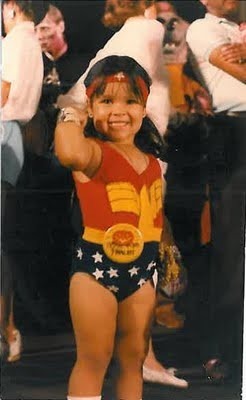 How long did you keep the show on your résumé? What other jobs, if any, did the SWSH help you get?
How long did you keep the show on your résumé? What other jobs, if any, did the SWSH help you get?
Al Kelley: It landed my current job as an animal trainer. I worked 25 years as a full-time animal trainer and when they closed the Ohio park for good I ended up at Dolphin Cay, Atlantis, in Nassau, the Bahamas.
Betsy Maher (Hawkins): I did some artwork while skiing for the marketing department. [Around 1986] I interviewed with Sea World marketing the day the graphic artist [on staff] left to have her first child. Good timing.
Bill Schwartz: It's still on my résumé.
Gary Thompson: It is still on my résumé along with all the shows I have ever done.
Jeff Parnell: I taught a real estate developer's kids to ski and he gave me a job when I was ready to leave [Sea World]. That was how I got out. It wasn't easy to find a job that paid as well and was as much fun. There were guys much older than me that stayed too long.
Jody Spence: My skiing career was my first career, on and off for 15 or so years. I had two kids while I was skiing. It has always been part of my résumé
Linda Knapp (Moffett): A few years. It never really helped me get a particular job, just showed that I was a reliable employee. It has always been a conversation starter, however.
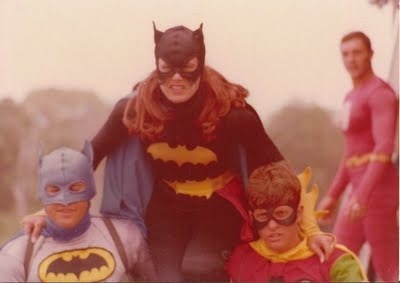 Randy Messer: The Sea World mention on my résumé always helped even if unrelated to the job, such as programming.
Randy Messer: The Sea World mention on my résumé always helped even if unrelated to the job, such as programming.
Reyna Blasko: I spent 15 years water skiing professionally. It is so sad other people do not have the same opportunities.
How many SWSH performers have you been in touch with continuously since the show ended?
Suzanne Schwartz: Several! And it was via Facebook that we found out about a 50th birthday party that was taking place for John Macqueen (AKA "John-Boy" or "JB"). John started at Sea World in Ohio when he was 15. Sharkey and I decided we simply couldn't miss that occasion and flew back to Orlando (from California) to surprise him at his party. There were a BUNCH of former skiers there. It was a wonderfully special, spectacular night.
Bill Schwartz: I'm in touch with about ten skiers on a regular basis. [In 2009 we] had a reunion birthday party for John Macqueen and there must a have been 30-35 skiers from back then who came. Two flew in from California and one from Ohio. It was fantastic. We socialized till 3 a.m. I would say we all have a timeless friendship.
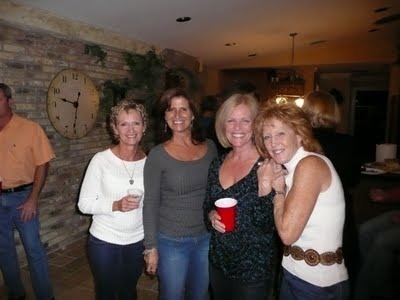
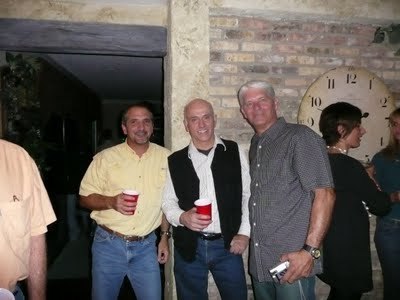
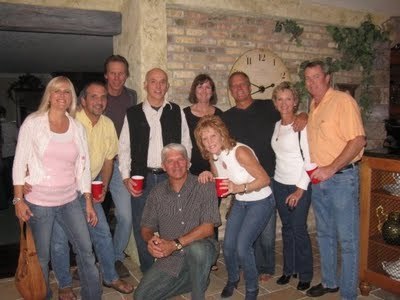 Bubby Snow: Nearly every skier in the show.
Bubby Snow: Nearly every skier in the show.
Carl Lipsit: Only one.
Dave Madeline: We just had a kind of birthday party [in late 2009]. That was the first time I'd seen most of them in 20 years.
Diane Smith: Past Christmases, I would look forward to the wonderful updates from my friend Debbie Blake (Berndt), who was instrumental in teaching me to become the skier that I was. She often gave up her lunch breaks in order to show me how to be a better swivel skier. She had my greatest respect; she could do anything on skis and she was afraid of nothing. We used to get together when our children were young and I would take my girls to Sea World to watch her ski. Sometimes I will run into other locals, like Mary Beth McMurtrie, and when I do, we remember each other and catch up. I guess it is good that we can still recognize one another after so many years. Perhaps [your] project will bring us all together again.
Doby Buesse: About a half dozen.
Gary Thompson: None continuously but several from time to time.
Janalee Zimmerman (Addleman): Unfortunately none.
Jeff Parnell: The youngest skiers on the team were myself, Mark Taylor, John Macqueen, Greg Galloway, and Doby Buesse. We stay in touch to this day.
Kaci Whittenton (Hedstrum): Mary McMurtrie is the only one I really kept in touch with and she keeps me up-to-date the on skier scoop.
Linda Knapp (Moffett): At first, quite a few. Over the years hardly any.
Lori Taylor: One, my husband Mark.
Mark Gutleben: I'm in touch with Fontaine periodically. He's the only one I could contact. If I had other numbers I would. Roland Hillier was teaching King Hussein's kids how to water ski. They paid to fly him out to Saudi Arabia. I'd like to talk to him again.
Nancy Radant Combes: Lots and lots.
Sherry Wickstrom: None. I used to date Dave Madeline and we would call each other on occasions.
Shirley Duke: Not too many since the 10-year reunion. We were supposed to have a 20-year reunion but it didn't materialize. My husband and I were busy raising our three children and going to ski tournaments. Dave Madeline is the only one that my husband and I have stayed in touch with regularly. I went to Bob Borth's memorial and reconnected with the skiers who were there. Sometimes we see Bill and Barbara Peterson around town. They came to our 30th wedding anniversary.
How many SWSH performers did you reconnect with via Facebook?
Christina Ashley: Many!
Cindy Barhoff (Clasen): Two.
Kaci Whittenton (Hedstrum): I haven't really reconnected with any of them but Facebook has enabled me to get a peek into their family and what they are all doing as grown-ups. It's fun to see what they are all up to—children and grandchildren.
Kerry Lloyd: Not on Facebook. I'm not a me, me, me kind of person.
Margie LaPoint (Bates): The girls and guys in the show were some of my best friends at the time. I have not connected with any of them through Facebook, though I would like to.
Mary McMurtrie: It was wonderful…found just about everybody again.
Nancy Radant Combes: Lots.
Sherry Satterfield Runion: I value the relationships, especially how in the last few years [we] have made an effort to stay connected or to reconnect. My dear friend from Sea World Ohio, Cindy Clausen Barhoff, and I just got back together via Facebook. Another happy reunion—planning to meet before year's end and spend time together.
Shirley Duke: I didn't know there were any [on] there. I think I'll do that.
[UPDATE: I'm happy to report that even more have reconnected since this series began!]
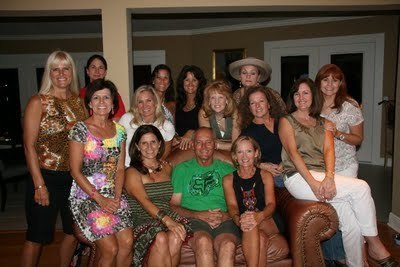 Tom Weber and the ladies, 2011
Tom Weber and the ladies, 2011
Skiers, part 9 of 10.

Introduction to subseries "Sea World superheroes show" (including list of interviewees).
Skiers, part 7 of 10.
SWSH = Sea World superheroes
AFTER THE SHOW CLOSED
Have you had anything to do with superheroes since?
Al Kelley: I was Robin at a Halloween party and made a point of watching all superhero movies such as the Superman and Batman movies.
Bill Peterson: No, not really. My son was into it as a child—wore a cape it seemed forever. If we forgot his cape at home, his mom had to pin a dish towel or something to his T-shirt or he was not happy. Bill's wife Barbara] I think he wore a cape until he was about five years old—night and day.
Bill Schwartz: Yes, I have a collection of about 2,000 comics. I collected and drew comics as a kid. I do not collect anymore but I still have my collection. I have seen just about every superhero movie made, especially Marvel [ones]. I am a big comic fan.
Nancy Radant Combes: Nope, just in my dreams.
Randy Messer: The company I'm currently with Digitec promotes itself as creative and we did a staff shoot where we all dressed as superheroes/villains.
Shirley Duke: My son collected comic books, especially Superman and Spider-Man. For my daughter's first Halloween, I sewed her a Wonder Woman costume. She won 1st place in her age group at Disney World.
 How long did you keep the show on your résumé? What other jobs, if any, did the SWSH help you get?
How long did you keep the show on your résumé? What other jobs, if any, did the SWSH help you get?Al Kelley: It landed my current job as an animal trainer. I worked 25 years as a full-time animal trainer and when they closed the Ohio park for good I ended up at Dolphin Cay, Atlantis, in Nassau, the Bahamas.
Betsy Maher (Hawkins): I did some artwork while skiing for the marketing department. [Around 1986] I interviewed with Sea World marketing the day the graphic artist [on staff] left to have her first child. Good timing.
Bill Schwartz: It's still on my résumé.
Gary Thompson: It is still on my résumé along with all the shows I have ever done.
Jeff Parnell: I taught a real estate developer's kids to ski and he gave me a job when I was ready to leave [Sea World]. That was how I got out. It wasn't easy to find a job that paid as well and was as much fun. There were guys much older than me that stayed too long.
Jody Spence: My skiing career was my first career, on and off for 15 or so years. I had two kids while I was skiing. It has always been part of my résumé
Linda Knapp (Moffett): A few years. It never really helped me get a particular job, just showed that I was a reliable employee. It has always been a conversation starter, however.
 Randy Messer: The Sea World mention on my résumé always helped even if unrelated to the job, such as programming.
Randy Messer: The Sea World mention on my résumé always helped even if unrelated to the job, such as programming.Reyna Blasko: I spent 15 years water skiing professionally. It is so sad other people do not have the same opportunities.
How many SWSH performers have you been in touch with continuously since the show ended?
Suzanne Schwartz: Several! And it was via Facebook that we found out about a 50th birthday party that was taking place for John Macqueen (AKA "John-Boy" or "JB"). John started at Sea World in Ohio when he was 15. Sharkey and I decided we simply couldn't miss that occasion and flew back to Orlando (from California) to surprise him at his party. There were a BUNCH of former skiers there. It was a wonderfully special, spectacular night.
Bill Schwartz: I'm in touch with about ten skiers on a regular basis. [In 2009 we] had a reunion birthday party for John Macqueen and there must a have been 30-35 skiers from back then who came. Two flew in from California and one from Ohio. It was fantastic. We socialized till 3 a.m. I would say we all have a timeless friendship.


 Bubby Snow: Nearly every skier in the show.
Bubby Snow: Nearly every skier in the show.Carl Lipsit: Only one.
Dave Madeline: We just had a kind of birthday party [in late 2009]. That was the first time I'd seen most of them in 20 years.
Diane Smith: Past Christmases, I would look forward to the wonderful updates from my friend Debbie Blake (Berndt), who was instrumental in teaching me to become the skier that I was. She often gave up her lunch breaks in order to show me how to be a better swivel skier. She had my greatest respect; she could do anything on skis and she was afraid of nothing. We used to get together when our children were young and I would take my girls to Sea World to watch her ski. Sometimes I will run into other locals, like Mary Beth McMurtrie, and when I do, we remember each other and catch up. I guess it is good that we can still recognize one another after so many years. Perhaps [your] project will bring us all together again.
Doby Buesse: About a half dozen.
Gary Thompson: None continuously but several from time to time.
Janalee Zimmerman (Addleman): Unfortunately none.
Jeff Parnell: The youngest skiers on the team were myself, Mark Taylor, John Macqueen, Greg Galloway, and Doby Buesse. We stay in touch to this day.
Kaci Whittenton (Hedstrum): Mary McMurtrie is the only one I really kept in touch with and she keeps me up-to-date the on skier scoop.
Linda Knapp (Moffett): At first, quite a few. Over the years hardly any.
Lori Taylor: One, my husband Mark.
Mark Gutleben: I'm in touch with Fontaine periodically. He's the only one I could contact. If I had other numbers I would. Roland Hillier was teaching King Hussein's kids how to water ski. They paid to fly him out to Saudi Arabia. I'd like to talk to him again.
Nancy Radant Combes: Lots and lots.
Sherry Wickstrom: None. I used to date Dave Madeline and we would call each other on occasions.
Shirley Duke: Not too many since the 10-year reunion. We were supposed to have a 20-year reunion but it didn't materialize. My husband and I were busy raising our three children and going to ski tournaments. Dave Madeline is the only one that my husband and I have stayed in touch with regularly. I went to Bob Borth's memorial and reconnected with the skiers who were there. Sometimes we see Bill and Barbara Peterson around town. They came to our 30th wedding anniversary.
How many SWSH performers did you reconnect with via Facebook?
Christina Ashley: Many!
Cindy Barhoff (Clasen): Two.
Kaci Whittenton (Hedstrum): I haven't really reconnected with any of them but Facebook has enabled me to get a peek into their family and what they are all doing as grown-ups. It's fun to see what they are all up to—children and grandchildren.
Kerry Lloyd: Not on Facebook. I'm not a me, me, me kind of person.
Margie LaPoint (Bates): The girls and guys in the show were some of my best friends at the time. I have not connected with any of them through Facebook, though I would like to.
Mary McMurtrie: It was wonderful…found just about everybody again.
Nancy Radant Combes: Lots.
Sherry Satterfield Runion: I value the relationships, especially how in the last few years [we] have made an effort to stay connected or to reconnect. My dear friend from Sea World Ohio, Cindy Clausen Barhoff, and I just got back together via Facebook. Another happy reunion—planning to meet before year's end and spend time together.
Shirley Duke: I didn't know there were any [on] there. I think I'll do that.
[UPDATE: I'm happy to report that even more have reconnected since this series began!]
 Tom Weber and the ladies, 2011
Tom Weber and the ladies, 2011Skiers, part 9 of 10.
Published on September 10, 2011 04:49
September 9, 2011
"Boys of Steel" as a curriculum tie-in
Please come back tomorrow for the continuation of the massive "Super '70s and '80s" series, running most days between now and 10/12/11! And for today, a post of "regularly scheduled content":
When I was in elementary school, the real-life origin of Superman was not on the test. Or in the textbooks.
Today, of course, it still isn't.
But that doesn't mean my nonfiction picture book Boys of Steel: The Creators of Superman is not relevant to curriculum.
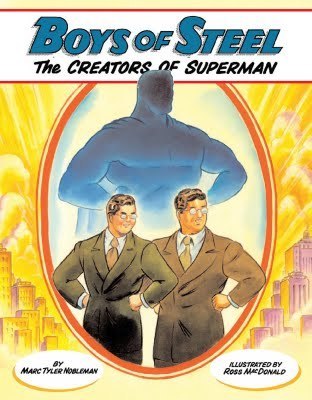 The events of the illustrated portion of the book take place between roughly 1930 and 1940. The text-only, three-page afterword takes the reader through the rest of the lives of writer Jerry Siegel and artist Joe Shuster.
The events of the illustrated portion of the book take place between roughly 1930 and 1940. The text-only, three-page afterword takes the reader through the rest of the lives of writer Jerry Siegel and artist Joe Shuster.
Their story spans almost the entire century (both born in 1914, both died in the 1990s), but perhaps the most fertile way to incorporate the book into curriculum is via the Great Depression and World War II.
Here are review excerpts that mention one or both of these periods:
Fuse #8, a School Library Journal blog: "Nobleman even manages to draw ties to Superman's rise alongside WWII. Here was America in a strange war and 'People wanted a hero they knew would always come home. Jerry and Joe gave them that—the world's first superhero.' The amount of research necessary for a book of this scope would have to be hefty and I was pleased to see a small list of Selected Sources available on the publication page."
Playback STL (St. Louis): "The story takes place during the Great Depression, yet just as easily speaks to the children of our own era. Author Marc Nobleman does not condescend to his young readers, nor does he shirk from mentioning the economic straits of the 1930s and the menace of World War II. Astute adults will draw parallels to modern events and hopefully both discern and reiterate an important underlying message: Bad times are coming, hard times are already here, and you know what? You can still make your dreams happen."
Firefox News: "Boys of Steel, a 70th anniversary celebration of Superman's debut, is...written by Marc Nobleman, a comics historian of sorts with a gift for dramatizing the creative process. [It] deftly sketch[es] the pop cultural context for comics' Golden Age; vividly bringing to life an entire era—socially and politically—and showing how it was reflected in the escapist entertainment of the day."
Kirkus: "Nobleman retraces Superman's role in World War II and beyond..."
School Library Journal: "The afterword fills in more of the details, including...how their Jewish background affected Superman during World War II..."
Read That Again: "...it does address the misery of the Great Depression..."
Good Reads member Nomi: "I appreciated how the author and illustrator team of this book placed the creation of this superhero in the context of the Great Depression and WWI, a time when Americans needed to believe in heroes."
Epinions: "The authors point out...that...the Great Depression itself...primed the pump for the particular kind of hero that Superman became."
WIRED GeekDad blog: "My seven-year-old son read the whole thing in about fifteen minutes, pronounced it 'great,' and then read it again the next day (entirely voluntarily)."
Here are sites that encourage bringing superheroes, comics, and/or picture books in the classroom:
Reading With Pictures—Josh Elder
Comics in the Classroom—Scott Tingley
Graphic Classroom—Chris Wilson
Teach With Picture Books—Keith Schoch
I've been in touch with all of these sites; if you contact any of them, tell them I sent you.
Here are ways to use Boys of Steel in the classroom, courtesy of others:
ReadWriteThing.org has posted a lesson plan intriguingly called "Is Superman Really All That Super?" (The answer is simple: come on. But still worth exploring.)
An Ohio teacher shared with me the lesson plan based on the book that he created, and he gave me permission to share it. Would you like me to email it to you?
Here are ways to use Boys of Steel in the classroom, courtesy of me:
Explain the difference between "hero" and "superhero" and between an everyday person and a hero.Explain whether or not the Boys of Steel (Jerry and Joe) were heroes.Explain if you think Superman would've been as popular if he debuted at another time (i.e. not on the fence between the Great Depression and World War II).Joe drew Superman based on Jerry's verbally described concept. Teachers: Ask half the students in the class to create a superhero by description only (meaning explaining who the hero is and what he can do, not what he looks like) and pair them up with the other half to draw those heroes based on the descriptions. (In other words, divide the whole class into writer-artist pairs.)In WWII, the U.S. government sent Superman comic books to American soldiers overseas. Explain why you think the government did this and what you think the soldiers thought of it.
For older elementary:
Jerry and Joe did not want to create a story in which Superman quickly ended WWII. Explain why you think they felt that way.Pick three superheroes (besides Superman). Find out when each was introduced. Speculate why each hero came out when s/he did. Do you think any are a product uniquely of their times or could they have been created anytime?Read the author's note in Boys of Steel. Explain what if anything you think Jerry and Joe could have done differently to help themselves.It's been observed that superheroes have increased appeal during periods of real-world strife. Explain why you think this happens.Superman is said to represent "truth, justice, and the American way." Explain what you think that means. Do you think "American way" has the same meaning now as it did when Superman debuted in 1938?
When I was in elementary school, the real-life origin of Superman was not on the test. Or in the textbooks.
Today, of course, it still isn't.
But that doesn't mean my nonfiction picture book Boys of Steel: The Creators of Superman is not relevant to curriculum.
 The events of the illustrated portion of the book take place between roughly 1930 and 1940. The text-only, three-page afterword takes the reader through the rest of the lives of writer Jerry Siegel and artist Joe Shuster.
The events of the illustrated portion of the book take place between roughly 1930 and 1940. The text-only, three-page afterword takes the reader through the rest of the lives of writer Jerry Siegel and artist Joe Shuster.Their story spans almost the entire century (both born in 1914, both died in the 1990s), but perhaps the most fertile way to incorporate the book into curriculum is via the Great Depression and World War II.
Here are review excerpts that mention one or both of these periods:
Fuse #8, a School Library Journal blog: "Nobleman even manages to draw ties to Superman's rise alongside WWII. Here was America in a strange war and 'People wanted a hero they knew would always come home. Jerry and Joe gave them that—the world's first superhero.' The amount of research necessary for a book of this scope would have to be hefty and I was pleased to see a small list of Selected Sources available on the publication page."
Playback STL (St. Louis): "The story takes place during the Great Depression, yet just as easily speaks to the children of our own era. Author Marc Nobleman does not condescend to his young readers, nor does he shirk from mentioning the economic straits of the 1930s and the menace of World War II. Astute adults will draw parallels to modern events and hopefully both discern and reiterate an important underlying message: Bad times are coming, hard times are already here, and you know what? You can still make your dreams happen."
Firefox News: "Boys of Steel, a 70th anniversary celebration of Superman's debut, is...written by Marc Nobleman, a comics historian of sorts with a gift for dramatizing the creative process. [It] deftly sketch[es] the pop cultural context for comics' Golden Age; vividly bringing to life an entire era—socially and politically—and showing how it was reflected in the escapist entertainment of the day."
Kirkus: "Nobleman retraces Superman's role in World War II and beyond..."
School Library Journal: "The afterword fills in more of the details, including...how their Jewish background affected Superman during World War II..."
Read That Again: "...it does address the misery of the Great Depression..."
Good Reads member Nomi: "I appreciated how the author and illustrator team of this book placed the creation of this superhero in the context of the Great Depression and WWI, a time when Americans needed to believe in heroes."
Epinions: "The authors point out...that...the Great Depression itself...primed the pump for the particular kind of hero that Superman became."
WIRED GeekDad blog: "My seven-year-old son read the whole thing in about fifteen minutes, pronounced it 'great,' and then read it again the next day (entirely voluntarily)."
Here are sites that encourage bringing superheroes, comics, and/or picture books in the classroom:
Reading With Pictures—Josh Elder
Comics in the Classroom—Scott Tingley
Graphic Classroom—Chris Wilson
Teach With Picture Books—Keith Schoch
I've been in touch with all of these sites; if you contact any of them, tell them I sent you.
Here are ways to use Boys of Steel in the classroom, courtesy of others:
ReadWriteThing.org has posted a lesson plan intriguingly called "Is Superman Really All That Super?" (The answer is simple: come on. But still worth exploring.)
An Ohio teacher shared with me the lesson plan based on the book that he created, and he gave me permission to share it. Would you like me to email it to you?
Here are ways to use Boys of Steel in the classroom, courtesy of me:
Explain the difference between "hero" and "superhero" and between an everyday person and a hero.Explain whether or not the Boys of Steel (Jerry and Joe) were heroes.Explain if you think Superman would've been as popular if he debuted at another time (i.e. not on the fence between the Great Depression and World War II).Joe drew Superman based on Jerry's verbally described concept. Teachers: Ask half the students in the class to create a superhero by description only (meaning explaining who the hero is and what he can do, not what he looks like) and pair them up with the other half to draw those heroes based on the descriptions. (In other words, divide the whole class into writer-artist pairs.)In WWII, the U.S. government sent Superman comic books to American soldiers overseas. Explain why you think the government did this and what you think the soldiers thought of it.
For older elementary:
Jerry and Joe did not want to create a story in which Superman quickly ended WWII. Explain why you think they felt that way.Pick three superheroes (besides Superman). Find out when each was introduced. Speculate why each hero came out when s/he did. Do you think any are a product uniquely of their times or could they have been created anytime?Read the author's note in Boys of Steel. Explain what if anything you think Jerry and Joe could have done differently to help themselves.It's been observed that superheroes have increased appeal during periods of real-world strife. Explain why you think this happens.Superman is said to represent "truth, justice, and the American way." Explain what you think that means. Do you think "American way" has the same meaning now as it did when Superman debuted in 1938?
Published on September 09, 2011 04:45
September 8, 2011
Super '70s and '80s: Sea World superheroes water ski show—the skiers, part 7 of 10
Introduction to series "Super '70s and '80s."
Introduction to subseries "Sea World superheroes show" (including list of interviewees).
Skiers, part 6 of 10.
SWSH = Sea World superheroes
THE RELATIONSHIPS
How much time did your group of SWSH show skiers spend together both professionally and socially?
Al Kelley: During the summers in Ohio we all worked 6 days a week and 12-hour days so we didn't have much time off. Late dinners and a drink after the 9 p.m. show.
Andy Hansen: We became very good friends. Many permanent relationships were established. I ended up meeting my wife in the ski show at Sea World.
Bill Peterson: I was married and had a young baby so I did not spend much time except for the show work and a few parties. We did try to help each other out with temporary housing when a new person came in. I practiced some outside the show with Margie Bates since she was a competitive skier, too. I always kept up competitive skiing even while I worked at Sea World. Most show skiers didn't do both; I think me and Margie and a few others were the exception.
Bill Schwartz: All day and all night. Many of us lived together or in the same areas. We socialized almost every night and had many parties. We all became very tight like one big family. Our friendships were and are very deep and I have the warmest place in my heart for everyone.
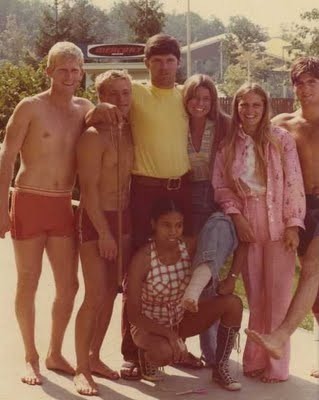 Carl Lipsit: On the professional side—quite a bit of time at work and practice. On the person side, quite a bit less. The occasional party. The guys got together to go to a lake (undisclosed location) and drank some beers that someone who wasn't working that day had to go out and buy.
Carl Lipsit: On the professional side—quite a bit of time at work and practice. On the person side, quite a bit less. The occasional party. The guys got together to go to a lake (undisclosed location) and drank some beers that someone who wasn't working that day had to go out and buy.
Christina Ashley: We actually spent quite a bit of time together. In a way we were a big family and most of us were very close. We did stunts that required a lot of teamwork, a lot of practicing. If you did not know what you were doing, it could be very dangerous, plus the girls were literally climbing on the guys in doubles, trio, and pyramid, you had to have a lot of trust in the person below you.
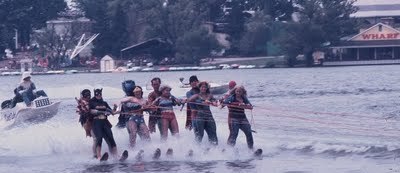 Cindy Barhoff (Clasen): Lots. There was sometimes four hours between shows.
Cindy Barhoff (Clasen): Lots. There was sometimes four hours between shows.
Dave Madeline: The skiers would have parties and everyone would bring Kodak carousels and everyone would be howling at the photos. Parties never lasted very long because everyone was tired at 9 p.m. In Ohio it was five or six shows a day.
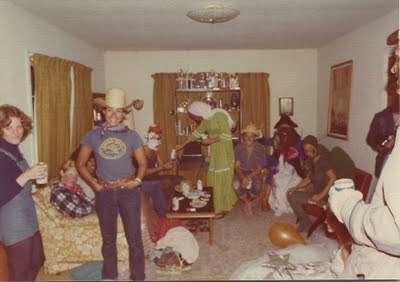
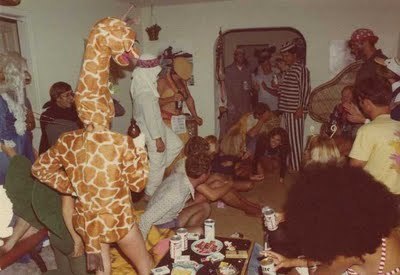 Diane Smith: We ate together and did Nautilus. When a holiday occurred, those of us who worked that day would celebrate the holiday after the park closed, at the home of a skier. I hosted some memorable parties—one on Halloween (what creative costumes there were) and another fun one was a '50s party where we dressed the era and danced to 45s which were played in my original "Happy Days-esque" jukebox. We drank out of superhero glasses.
Diane Smith: We ate together and did Nautilus. When a holiday occurred, those of us who worked that day would celebrate the holiday after the park closed, at the home of a skier. I hosted some memorable parties—one on Halloween (what creative costumes there were) and another fun one was a '50s party where we dressed the era and danced to 45s which were played in my original "Happy Days-esque" jukebox. We drank out of superhero glasses.
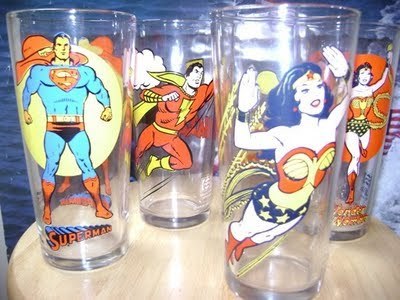
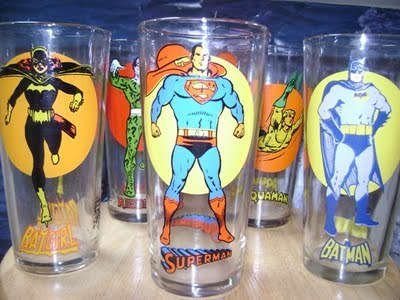
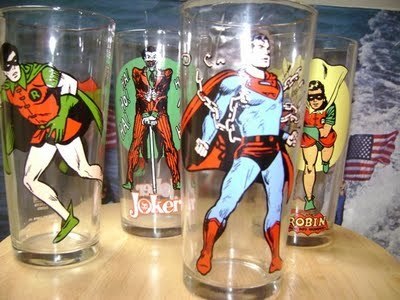
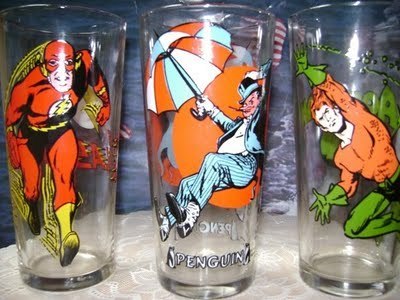 [Diane's superhero collectibles went beyond drinking glasses. She still has all of it.]
[Diane's superhero collectibles went beyond drinking glasses. She still has all of it.]
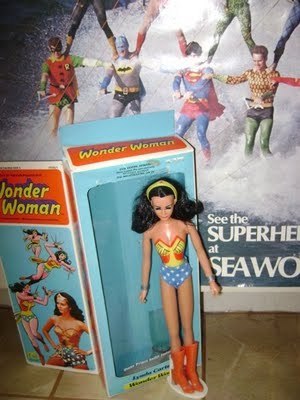
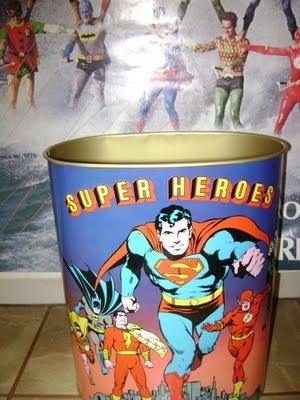
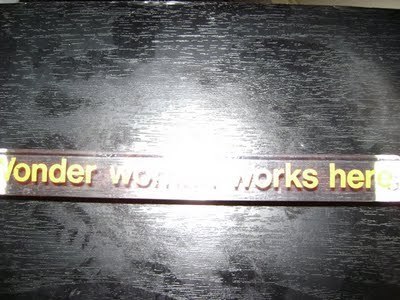 Two Wonder Women I interviewed for this feature—voice actor Shannon Farnon and
Two Wonder Women I interviewed for this feature—voice actor Shannon Farnon and
Sea World water skier Diane Smith—have this sign!
Greg Galloway: It was a pretty close group of people. I think, though, everybody had a life outside of work.
Janalee Zimmerman (Addleman): We worked eight hour days at times and as I recall there were days when we did up to seven shows, especially in July when the crowds were larger.
John Gillette: I shared an apartment with another skier. We also did quite a bit together as friends. Had a regular Bible study that several skiers attended.
Kerry Lloyd: A lot. It was pretty clique-y. I was with the hardcores. About seven or eight of us. The drinkers. Me, Jeff Parnell, Greg Galloway, Steve Fontaine, Billy Davies, Bubby Snow (he's a way hardcore), Doby Buesse, Lor Radant (definitely). If I told you some stories of what we did after work…ridiculous. At Rosie O'Grady's, Bubby almost jumped off the top balcony to swing on a chandelier. We got thrown out of everywhere we went. Gary Thompson, our show director, knew and tried to keep us tame. Within the first two weeks we got to Florida the park had a Halloween party. The green people [took care of the trees and shrubs of the park] threw it. Because we were so ornery, Bob Borth and Steve Fontaine set up this big diversion act and during it Bubby walked in right behind them and picked up a keg and walked out. Of course we got in trouble. Gary would have you scrubbing the stadium. He was about 6-7 years older than myself.
Nancy Radant Combes: We were inseparable. Since most of us lived away from our families, skiers were our family. Even today, we all have a special bond and love for each other. My husband, not a skier, is so amazed at the connection we all have.
Sherry Wickstrom: A lot. There was nothing to do up in Ohio. We partied at a place that was a restaurant and bar. We moved their tables and chairs so we had a dance floor. Lots of fun.
Suzanne Schwartz: The skiers were an extremely tight-knit group partly due to the amount of time spent together at work, partly due to the physical intimacy required for the job and the teamwork required, but we were all fairly close in age, had common interests, and personality traits and we thoroughly enjoyed each other's company at work or at play. I remember the first holiday we were there was Thanksgiving. Karen and Tommy Weber (married ski couple) hosted a "Thanksgiving Dinner for Orphans" for those skiers who had no family nearby.
How much behind-the-scenes romance among performers was there? How did it affect the show?
Al Kelley: There was a little. I think anytime you work with people as intimately as we did, you're going to have some relations. I don't remember it being a problem.
Andy Hansen: Lots! LOL. Talk to Gary and Sharkey. They were my mentors.
Bill Peterson: Never will tell.
Bill Schwartz: We could make a prime-time sitcom on this subject. Everyone was professional about it. A few got married and are still married.
Carl Lipsit: There was some of that went on from the top on down (no pun intended). Overall, it didn't seem to affect the show.
Diane Smith: The performers were professionals at work. Some were great friends; others were in love and then got married. The show, however, was never affected and during my time there. These relationships seemed to make certain acts even stronger.
Doby Buesse: There was a fair amount. Young, single, spending all day in bathing suits. It happens.
Gary Thompson: I'm an example. My wife was one of our many Wonder Women. She was hired into the show and that is when we first met.
Greg Galloway: It was the late 1970s and most skiers were in their late teens or early twenties. What do you think?
Jacque Cook (Kuntarich): It was unrelated to Sea World and never affected the show, but some of the skiers became Born Again and others were the partiers. Some didn't want to go dirt biking around the back after work. It's the Shamu Stadium now but it was woods then.
Janalee Zimmerman (Addleman): There was a girl named Cindy Clasen who dated the guy whose shoulder I dislocated.
Jody Spence: Several or so. I think at times there might have been some problems, but as a whole it was more fun to be with people that love the same thing.
Kerry Lloyd: Tiger's [as in Tiger Woods] nothing. (laughs) Romance with the hardcores was pretty much one-night stands. That's how Orlando worked—people fly in Monday and fly out Sunday. We'd meet all these girls in the stadium, 5,000 people. We'd break character and say "Stick around, I'll be here when this is over." Eventually I married a girl that I had children with.
Paula Nelson (Bloemer): Quite a bit! Hey, the show must go on and it did!
Randy Messer: Skier dating non-skier almost never lasted. The guys were, for the most part, having a great time; a majority every work day was spent interacting with beautiful, athletic girls in swimsuits. The girls had more time on their hands and were much more volatile.
Wow, seeing the girls dressed (or undressed) as superheroines was a real treat for the guys. Before the show everyone was grabbing costumes. The guys had to put on chest padding for fake muscles and the girls put padded bras over bikini tops (mostly) to meet the superhero standards. Pre-show was always a madhouse and then there were costume changes throughout the show. Performers running through the hall stripping off [some] costume pieces—think Maxim, not Playboy. (Girls were always covered.) Most skiers I talk to still have dreams where they can't find their costume and fear missing the next act.
The girls' costume consisted of spandex tights (somewhere in heaven there is a spot reserved for the inventor of spandex) pulled over a very padded bra, topped off with a large, luxurious wig and show makeup. The bras were not exactly Victoria's Secret and I think the girls probably viewed them as not sexy at all— something their grandmother might wear. But to a young man, a bra is a bra. It evokes a certain reaction when an attractive young woman strides down the hallway wearing a bra, the bottom half of a Supergirl outfit, a blonde wig, and bright red lipstick. Some ski shows girls were absolute knockouts but even the Plain Janes transformed into objects of desire with the right costume and makeup.
Just like in junior high, the guys would steal glances down the tops of these poorly fitted bras whenever possible. In later shows there was a pig costume worn by girls. It had a big head piece that someone could look out of but no one could see in. Kerry Lloyd, one of the smaller male skiers, slipped the costume on and walked into the girls locker room and hung out for a bit until the girls realized they were all accounted for and there was one left over, being the pig. Exit Kerry Lloyd.
[Another time Kerry Lloyd dressed in an outfit made for the girls, but this time it was a cat(woman) instead of a pig.]
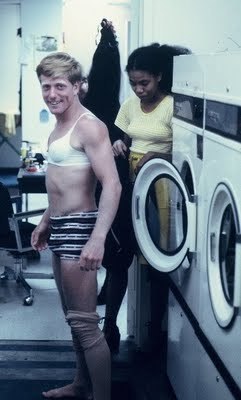
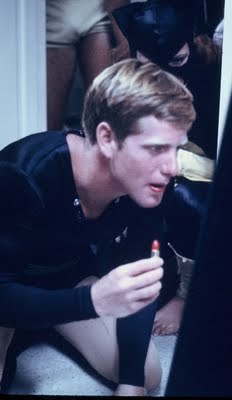
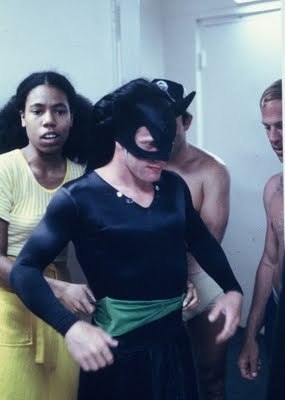 I have often wondered how the girls felt about wearing these outfits and if they were aware of the super powers they truly possessed.
I have often wondered how the girls felt about wearing these outfits and if they were aware of the super powers they truly possessed.
Reyna Blasko: Some. The age was right. I met and married during the show. He was Tarzan.
Suzanne Schwartz: There was lots and lots of romance amongst skiers. Put a bunch of athletic, outgoing, attractive guys and gals together…running around in bathing suits…and being required to be physical with each other…you get the drift. During off season there was a lot of time between shows…that time could be filled doing whatever people wanted to do…practicing, tanning, working out, or just hanging out with each other. In all honesty, I don't believe romance affected the show whatsoever. Offhand I know of 11 skier couples from our era alone who married and eight of the 11 are still married (and most are becoming grandparents now).
Was there a rivalry between the skiers of the Florida and Ohio SWSH shows?
Andy Hansen: Oh, yeah. It was stupid that there was. In my opinion this did not have to exist. I think management created it. I am probably going to get called out on that one…grins.
Bubby Snow: No, many were the same skiers.
Diane Smith: I would be more intimidated by eight Cypress Gardens skiers in the audience than a full audience of thousands.
Doby Buesse: No. It was always nice to have the Ohio skiers back in Orlando at the end of the summer.
Greg Galloway: Maybe, but everybody knew that the skiers from Florida were the best.
Sherry Wickstrom: No. Florida was more professional.
Shirley Duke: I think the first Ohio skiers were tight as a group, and then getting relocation pay to move to Florida, wow, how cool is that? So maybe there was a little attitude there, but we all came together. I had heard of Randi Tetrick and Mike Botti who were well known barefooters and Bill Peterson who was a champion trick skier. Both had appeared in Water Skier magazine. So it was great to have such a caliber of skiers added to the team. I believe there was a little rivalry between the Cypress Gardens skiers and the Florida skiers. We'd visit their show on our days off.
If there were any rivalries among skiers, how did they play out?
Bill Peterson: Not really. We always skied as a team and [a goal was] to do a no-fall show every time. For each fall in the show, the fallen skiers would put a quarter in the kitty and after so much time, the funds would go towards a party for the skiers.
Christina Ashley: You would always have the few who were jealous of others' abilities, but for the most part there was not much of that going on.
Jeff Parnell: There just wasn't much of that. The only real rivalry was between the whale and dolphin trainers and skiers. They were top dog until we showed up.
Linda Knapp (Moffett): Not really. We all helped one another improve. Our goal was to be the best we could be in each act. We practiced a lot between shows. There was some competition between skiers at Sea World and Cypress Gardens. Each group boasted of their talents (which were pretty much equal). Also, Mercury Motors sponsored Sea World and Johnson sponsored the Gardens.
Randy Messer: There were a few rifts. The show director Gary and assistant show director Tommy were different personalities and skiers sided with one or the other. Within the first few months after being hired a group of skiers headed by the lead skier wanted to strike. The motivation behind the strike was not just for pay increase. They put together a list of things they wanted and one of the items was a request to have an old guy around that the skiers could talk to when they were upset. The strike required full participation and I said no and slowly made a few others realize they were putting their jobs in jeopardy and other skiers from Cypress of other places would love to fill the positions. Later on there was rift between a group of Born Again Christian skiers and those that weren't.
Steve Fontaine: Once during a show, one of the girls smeared cold cream all over one of the boy's faces. To get even, the guys filled the girls' ski binders with elephant dookie!
Next: skiers, part 8 of 10.

Introduction to subseries "Sea World superheroes show" (including list of interviewees).
Skiers, part 6 of 10.
SWSH = Sea World superheroes
THE RELATIONSHIPS
How much time did your group of SWSH show skiers spend together both professionally and socially?
Al Kelley: During the summers in Ohio we all worked 6 days a week and 12-hour days so we didn't have much time off. Late dinners and a drink after the 9 p.m. show.
Andy Hansen: We became very good friends. Many permanent relationships were established. I ended up meeting my wife in the ski show at Sea World.
Bill Peterson: I was married and had a young baby so I did not spend much time except for the show work and a few parties. We did try to help each other out with temporary housing when a new person came in. I practiced some outside the show with Margie Bates since she was a competitive skier, too. I always kept up competitive skiing even while I worked at Sea World. Most show skiers didn't do both; I think me and Margie and a few others were the exception.
Bill Schwartz: All day and all night. Many of us lived together or in the same areas. We socialized almost every night and had many parties. We all became very tight like one big family. Our friendships were and are very deep and I have the warmest place in my heart for everyone.
 Carl Lipsit: On the professional side—quite a bit of time at work and practice. On the person side, quite a bit less. The occasional party. The guys got together to go to a lake (undisclosed location) and drank some beers that someone who wasn't working that day had to go out and buy.
Carl Lipsit: On the professional side—quite a bit of time at work and practice. On the person side, quite a bit less. The occasional party. The guys got together to go to a lake (undisclosed location) and drank some beers that someone who wasn't working that day had to go out and buy.Christina Ashley: We actually spent quite a bit of time together. In a way we were a big family and most of us were very close. We did stunts that required a lot of teamwork, a lot of practicing. If you did not know what you were doing, it could be very dangerous, plus the girls were literally climbing on the guys in doubles, trio, and pyramid, you had to have a lot of trust in the person below you.
 Cindy Barhoff (Clasen): Lots. There was sometimes four hours between shows.
Cindy Barhoff (Clasen): Lots. There was sometimes four hours between shows.Dave Madeline: The skiers would have parties and everyone would bring Kodak carousels and everyone would be howling at the photos. Parties never lasted very long because everyone was tired at 9 p.m. In Ohio it was five or six shows a day.

 Diane Smith: We ate together and did Nautilus. When a holiday occurred, those of us who worked that day would celebrate the holiday after the park closed, at the home of a skier. I hosted some memorable parties—one on Halloween (what creative costumes there were) and another fun one was a '50s party where we dressed the era and danced to 45s which were played in my original "Happy Days-esque" jukebox. We drank out of superhero glasses.
Diane Smith: We ate together and did Nautilus. When a holiday occurred, those of us who worked that day would celebrate the holiday after the park closed, at the home of a skier. I hosted some memorable parties—one on Halloween (what creative costumes there were) and another fun one was a '50s party where we dressed the era and danced to 45s which were played in my original "Happy Days-esque" jukebox. We drank out of superhero glasses.


 [Diane's superhero collectibles went beyond drinking glasses. She still has all of it.]
[Diane's superhero collectibles went beyond drinking glasses. She still has all of it.]

 Two Wonder Women I interviewed for this feature—voice actor Shannon Farnon and
Two Wonder Women I interviewed for this feature—voice actor Shannon Farnon andSea World water skier Diane Smith—have this sign!
Greg Galloway: It was a pretty close group of people. I think, though, everybody had a life outside of work.
Janalee Zimmerman (Addleman): We worked eight hour days at times and as I recall there were days when we did up to seven shows, especially in July when the crowds were larger.
John Gillette: I shared an apartment with another skier. We also did quite a bit together as friends. Had a regular Bible study that several skiers attended.
Kerry Lloyd: A lot. It was pretty clique-y. I was with the hardcores. About seven or eight of us. The drinkers. Me, Jeff Parnell, Greg Galloway, Steve Fontaine, Billy Davies, Bubby Snow (he's a way hardcore), Doby Buesse, Lor Radant (definitely). If I told you some stories of what we did after work…ridiculous. At Rosie O'Grady's, Bubby almost jumped off the top balcony to swing on a chandelier. We got thrown out of everywhere we went. Gary Thompson, our show director, knew and tried to keep us tame. Within the first two weeks we got to Florida the park had a Halloween party. The green people [took care of the trees and shrubs of the park] threw it. Because we were so ornery, Bob Borth and Steve Fontaine set up this big diversion act and during it Bubby walked in right behind them and picked up a keg and walked out. Of course we got in trouble. Gary would have you scrubbing the stadium. He was about 6-7 years older than myself.
Nancy Radant Combes: We were inseparable. Since most of us lived away from our families, skiers were our family. Even today, we all have a special bond and love for each other. My husband, not a skier, is so amazed at the connection we all have.
Sherry Wickstrom: A lot. There was nothing to do up in Ohio. We partied at a place that was a restaurant and bar. We moved their tables and chairs so we had a dance floor. Lots of fun.
Suzanne Schwartz: The skiers were an extremely tight-knit group partly due to the amount of time spent together at work, partly due to the physical intimacy required for the job and the teamwork required, but we were all fairly close in age, had common interests, and personality traits and we thoroughly enjoyed each other's company at work or at play. I remember the first holiday we were there was Thanksgiving. Karen and Tommy Weber (married ski couple) hosted a "Thanksgiving Dinner for Orphans" for those skiers who had no family nearby.
How much behind-the-scenes romance among performers was there? How did it affect the show?
Al Kelley: There was a little. I think anytime you work with people as intimately as we did, you're going to have some relations. I don't remember it being a problem.
Andy Hansen: Lots! LOL. Talk to Gary and Sharkey. They were my mentors.
Bill Peterson: Never will tell.
Bill Schwartz: We could make a prime-time sitcom on this subject. Everyone was professional about it. A few got married and are still married.
Carl Lipsit: There was some of that went on from the top on down (no pun intended). Overall, it didn't seem to affect the show.
Diane Smith: The performers were professionals at work. Some were great friends; others were in love and then got married. The show, however, was never affected and during my time there. These relationships seemed to make certain acts even stronger.
Doby Buesse: There was a fair amount. Young, single, spending all day in bathing suits. It happens.
Gary Thompson: I'm an example. My wife was one of our many Wonder Women. She was hired into the show and that is when we first met.
Greg Galloway: It was the late 1970s and most skiers were in their late teens or early twenties. What do you think?
Jacque Cook (Kuntarich): It was unrelated to Sea World and never affected the show, but some of the skiers became Born Again and others were the partiers. Some didn't want to go dirt biking around the back after work. It's the Shamu Stadium now but it was woods then.
Janalee Zimmerman (Addleman): There was a girl named Cindy Clasen who dated the guy whose shoulder I dislocated.
Jody Spence: Several or so. I think at times there might have been some problems, but as a whole it was more fun to be with people that love the same thing.
Kerry Lloyd: Tiger's [as in Tiger Woods] nothing. (laughs) Romance with the hardcores was pretty much one-night stands. That's how Orlando worked—people fly in Monday and fly out Sunday. We'd meet all these girls in the stadium, 5,000 people. We'd break character and say "Stick around, I'll be here when this is over." Eventually I married a girl that I had children with.
Paula Nelson (Bloemer): Quite a bit! Hey, the show must go on and it did!
Randy Messer: Skier dating non-skier almost never lasted. The guys were, for the most part, having a great time; a majority every work day was spent interacting with beautiful, athletic girls in swimsuits. The girls had more time on their hands and were much more volatile.
Wow, seeing the girls dressed (or undressed) as superheroines was a real treat for the guys. Before the show everyone was grabbing costumes. The guys had to put on chest padding for fake muscles and the girls put padded bras over bikini tops (mostly) to meet the superhero standards. Pre-show was always a madhouse and then there were costume changes throughout the show. Performers running through the hall stripping off [some] costume pieces—think Maxim, not Playboy. (Girls were always covered.) Most skiers I talk to still have dreams where they can't find their costume and fear missing the next act.
The girls' costume consisted of spandex tights (somewhere in heaven there is a spot reserved for the inventor of spandex) pulled over a very padded bra, topped off with a large, luxurious wig and show makeup. The bras were not exactly Victoria's Secret and I think the girls probably viewed them as not sexy at all— something their grandmother might wear. But to a young man, a bra is a bra. It evokes a certain reaction when an attractive young woman strides down the hallway wearing a bra, the bottom half of a Supergirl outfit, a blonde wig, and bright red lipstick. Some ski shows girls were absolute knockouts but even the Plain Janes transformed into objects of desire with the right costume and makeup.
Just like in junior high, the guys would steal glances down the tops of these poorly fitted bras whenever possible. In later shows there was a pig costume worn by girls. It had a big head piece that someone could look out of but no one could see in. Kerry Lloyd, one of the smaller male skiers, slipped the costume on and walked into the girls locker room and hung out for a bit until the girls realized they were all accounted for and there was one left over, being the pig. Exit Kerry Lloyd.
[Another time Kerry Lloyd dressed in an outfit made for the girls, but this time it was a cat(woman) instead of a pig.]


 I have often wondered how the girls felt about wearing these outfits and if they were aware of the super powers they truly possessed.
I have often wondered how the girls felt about wearing these outfits and if they were aware of the super powers they truly possessed.Reyna Blasko: Some. The age was right. I met and married during the show. He was Tarzan.
Suzanne Schwartz: There was lots and lots of romance amongst skiers. Put a bunch of athletic, outgoing, attractive guys and gals together…running around in bathing suits…and being required to be physical with each other…you get the drift. During off season there was a lot of time between shows…that time could be filled doing whatever people wanted to do…practicing, tanning, working out, or just hanging out with each other. In all honesty, I don't believe romance affected the show whatsoever. Offhand I know of 11 skier couples from our era alone who married and eight of the 11 are still married (and most are becoming grandparents now).
Was there a rivalry between the skiers of the Florida and Ohio SWSH shows?
Andy Hansen: Oh, yeah. It was stupid that there was. In my opinion this did not have to exist. I think management created it. I am probably going to get called out on that one…grins.
Bubby Snow: No, many were the same skiers.
Diane Smith: I would be more intimidated by eight Cypress Gardens skiers in the audience than a full audience of thousands.
Doby Buesse: No. It was always nice to have the Ohio skiers back in Orlando at the end of the summer.
Greg Galloway: Maybe, but everybody knew that the skiers from Florida were the best.
Sherry Wickstrom: No. Florida was more professional.
Shirley Duke: I think the first Ohio skiers were tight as a group, and then getting relocation pay to move to Florida, wow, how cool is that? So maybe there was a little attitude there, but we all came together. I had heard of Randi Tetrick and Mike Botti who were well known barefooters and Bill Peterson who was a champion trick skier. Both had appeared in Water Skier magazine. So it was great to have such a caliber of skiers added to the team. I believe there was a little rivalry between the Cypress Gardens skiers and the Florida skiers. We'd visit their show on our days off.
If there were any rivalries among skiers, how did they play out?
Bill Peterson: Not really. We always skied as a team and [a goal was] to do a no-fall show every time. For each fall in the show, the fallen skiers would put a quarter in the kitty and after so much time, the funds would go towards a party for the skiers.
Christina Ashley: You would always have the few who were jealous of others' abilities, but for the most part there was not much of that going on.
Jeff Parnell: There just wasn't much of that. The only real rivalry was between the whale and dolphin trainers and skiers. They were top dog until we showed up.
Linda Knapp (Moffett): Not really. We all helped one another improve. Our goal was to be the best we could be in each act. We practiced a lot between shows. There was some competition between skiers at Sea World and Cypress Gardens. Each group boasted of their talents (which were pretty much equal). Also, Mercury Motors sponsored Sea World and Johnson sponsored the Gardens.
Randy Messer: There were a few rifts. The show director Gary and assistant show director Tommy were different personalities and skiers sided with one or the other. Within the first few months after being hired a group of skiers headed by the lead skier wanted to strike. The motivation behind the strike was not just for pay increase. They put together a list of things they wanted and one of the items was a request to have an old guy around that the skiers could talk to when they were upset. The strike required full participation and I said no and slowly made a few others realize they were putting their jobs in jeopardy and other skiers from Cypress of other places would love to fill the positions. Later on there was rift between a group of Born Again Christian skiers and those that weren't.
Steve Fontaine: Once during a show, one of the girls smeared cold cream all over one of the boy's faces. To get even, the guys filled the girls' ski binders with elephant dookie!
Next: skiers, part 8 of 10.
Published on September 08, 2011 04:23
September 7, 2011
Super '70s and '80s: Sea World superheroes water ski show—the skiers, part 6 of 10
Introduction to series "Super '70s and '80s."
Introduction to subseries "Sea World superheroes show" (including list of interviewees).
Skiers, part 5 of 10.
SWSH = Sea World superheroes
THE AUDIENCE
Did the show involve volunteers or other audience participation?
Al Kelley: Yes, we always put a child into the Batboat for a ride around the lake. [The kids] were picked out of the audience by a member of the operations team. We also brought all the heroes on to the beach at the end of the show to meet the kids.
Andy Hansen: Kids dug [the Batboat segment] big time.
Bill Peterson: My son was 18 months when I started at Sea World so he grew up thinking his father was a superhero. He begged to ride in the Batboat when he saw the other kids doing it, but you had to be three. I think the day he turned three he got to ride. The highlight of his life, at least at three.
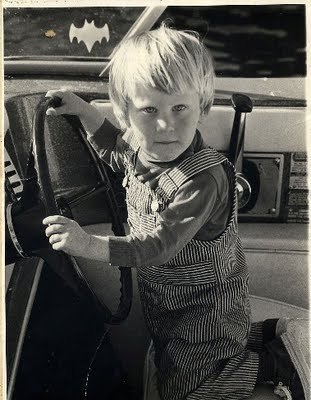 Bill Schwartz: Not really. But the villains did walk down the aisles [among] the audience.
Bill Schwartz: Not really. But the villains did walk down the aisles [among] the audience.
Cindy Barhoff (Clasen): Lois was dressed normally and planted there.
Doby Buesse: Most kids loved [the Batboat ride]. Others cried in fear!
Kaci Whittenton (Hedstrum): I recall the warm-up act [had] an out-of-control fliver boat which would prompt audience members to help.
Randy Messer: The Batboat ride turned into a chase sequence. You had to be careful the child didn't slide off his seat.
Steve Fontaine: We would get permission from a parent to use a pre-selected child to ride in the Batboat.
Did you do more at Sea World than perform in the show, i.e. walk the park/do appearances/meet and greet?
Bubby Snow: Two characters did meet and greet after the show and were required to sign autographs. I did participate in the 1977 Tangerine Bowl as Batman. We did appearances all the time all over Orlando. Sometimes it was people in the park that just dressed up for us. Sea World employees would represent the superheroes by dressing in our costumes for some of the exhibitions as we were paid hourly and this would [spare them from paying us] time-and-a-half.
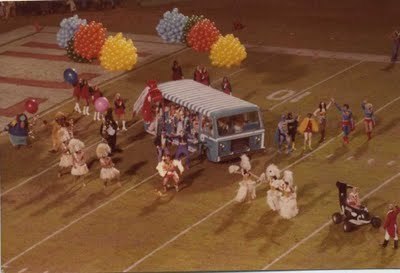 Carl Lipsit: No, but we did do maintenance on the equipment and motors.
Carl Lipsit: No, but we did do maintenance on the equipment and motors.
Diane Smith: The girl who was the full-time Wonder Woman representative at that time was not a water skier. We skiers were usually needed to perform on the water. [But] for our public relations department, I did visit places around town dressed as Wonder Woman, promoting Sea World and our show; I gave out signed Wonder Woman photos and Shamu shaped pins.
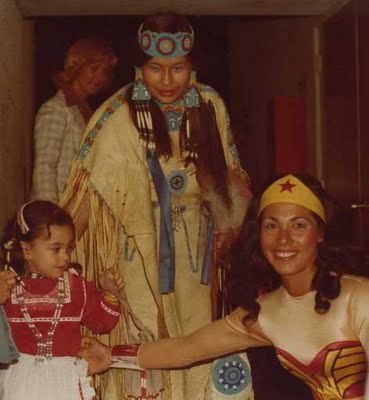 Doby Buesse: I remember doing a PR meet and greet. Afterwards the handlers took us to Red Lobster. We forgot to bring a change of clothes. A little surreal, Batman and Wonder Woman sitting at a booth eating those garlic bread rolls.
Doby Buesse: I remember doing a PR meet and greet. Afterwards the handlers took us to Red Lobster. We forgot to bring a change of clothes. A little surreal, Batman and Wonder Woman sitting at a booth eating those garlic bread rolls.
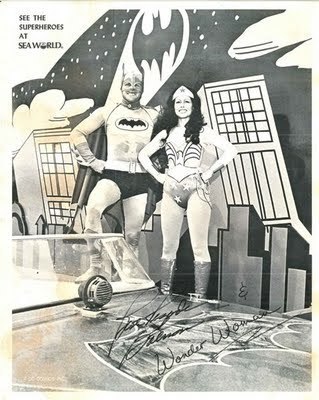 Janalee Zimmerman (Addleman): I got kissed by Shamu! We would occasionally walk in the park, but as I recall, not in costume. The skiers were definitely well-respected, though.
Janalee Zimmerman (Addleman): I got kissed by Shamu! We would occasionally walk in the park, but as I recall, not in costume. The skiers were definitely well-respected, though.
Kaci Whittenton (Hedstrum): Before I became a water skier I worked as a "Sea Maid" for two summers. I swam in a tank with tropical fish, performed a underwater ballet in the pearl diving pool, and dove for pearls as well.
Shirley Duke: We did personal appearances to promote the park and the show. Usually it was Wonder Woman, Batman and Robin, or Superman. We wore special costumes for those appearances, i.e., we didn't ski in them.
Did DC Comics reps attend any shows?
Linda Knapp (Moffett): We were always told that they could show up at any time to make sure we were accurately representing each character. We did meet a few of them.
Sherry Wickstrom: They did in Ohio and discovered we had two characters that were not DC characters. They had to take them out. [NOTE: One was Tarzan.]
Did people who'd portrayed a DC Comics superhero for film or TV (i.e. Adam West who played Batman, Lynda Carter who played Wonder Woman, Christopher Reeve who played Superman, etc.) attend any shows?
Andy Hansen: They didn't tell us if they did. I am certain if Adam was there, he would have wanted my autograph. LOL.
Did other celebrities attend any shows?
Andy Hansen: The Jackson Five with parents and Donnie Osmond are a couple I think I remember.
Bubby Snow: Dolly Parton, Lou Ferrigno, Richard Simmons.
Doby Buesse: King Hussein of Jordan. He was an avid water skier.
Gary Thompson: Ronald Reagan and others.
Kaci Whittenton (Hedstrum): Bill Cosby, Tony Orlando and Dawn, and I am sure many more but don't recall.
Kerry Lloyd: Many. Kris Kristofferson and that girl he was singing with at the time. We met Bob Hope. He was way, way, way intelligent.
Linda Knapp (Moffett): Crystal Gale.
Paula Nelson (Bloemer): Yeah, I think an actor from The Bob Newhart Show worked with us one day.
Sherry Wickstrom: In the Orlando show, they would have celebrities use our stage (floating) that put on shows. They usually watched one of our shows then took a picture with all of us. [I remember] Buddy Rich.
Shirley Duke: Ruth Buzzi did a guest appearance as Lois Lane; [that time], I portrayed her on the water skiing part. She was very personable and said I had done a great job impersonating her.
Suzanne Schwartz: Sea World had a floating stage that was parked across the lake and towed over to the beach for special concerts. Any celebrities involved with those concerts hung out in the "green room," which was beneath the stadium in the same area as our locker rooms and offices. The green room was close to the main stage entrance and they could easily watch the ski show from there without having to go into the stands. Some of the celebrities I can remember performing were the Oak Ridge Boys, Barbara Mandrell, Minnie Pearl, Charlie Pride, Wayne Newton.
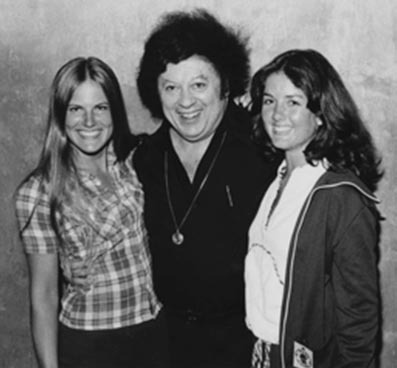 Two comely skiers with comedian Marty Allen
Two comely skiers with comedian Marty Allen
THE FAME
Did you feel like celebrities at the time? If so, only at Sea World or also around town? Were you ever recognized on the street or in line at the store?
Andy Hansen: Yes, around town. Not so much as superheroes because we were not in character outside of the park. However, as Sea World skiers we were often thought of as celebs. Yes, recognized a lot.
Bill Peterson: Did not feel like a celebrity except maybe when signing autographs. After leaving Sea World in June of '79, I went on to run my own competitive water ski school for the next 25 years. I think I was recognized for that more since my picture was in a few magazines when I wrote articles on coaching and I was on TV a few times. My wife Barbara has a funny story about one time when she was shopping for the ski school food—three grocery carts full! When she wrote the ski school check, the cashier said "Wow, Bill Peterson, your husband is famous." Barbara said "Not to me."
Bill Schwartz: Yes, I did feel kind of like a celebrity. Mainly as one of the skiers. People were most impressed with the skiing tricks we did. As far as a "superhero" celebrity, our young fans thought we were the real thing and wanted our autographs.
Bubby Snow: No, we were not recognized as celebrities, but people knew we were skiers as we had Sea World haircuts which were given to us at the park. It was a short military style haircut that was very different from the '70s style.
Carl Lipsit: I think that everyone felt a bit special at the time, even though probably it was only in the confines of the park. We had clothes that were different that normal park employees, so we were identifiable. We were invited to lots of parties that the other Sea World employees hosted if they wanted to it be a bit more exciting. Ha!
Cindy Barhoff (Clasen): At times, especially when we wore our warm-ups with "Sea World Water Ski Team" on back.
Dave Madeline: At the time, Sea World had a part-time show in Ohio. In 1976 they brought the Ohio show to Florida for full-time. We would go to a bar called Draft and Cinema and see a movie for $1. The guy who owned the cinema had pictures of different Florida parks on the walls. Before the movie they would show slides of our water skiing shows. In that way we felt like celebs.
Diane Smith: I never saw myself as a celebrity (although my high school students did). I believe it was because there were others who could ski as well, or better, than I. Since we shared acts, there was no real star. One show you could be the esteemed Wonder Woman in her solo swivel, and in the next you might be Lois Lane, or a thug (though you usually were other characters as well in that same show). We would not have been recognized elsewhere because we were never introduced as ourselves.
Doby Buesse: The skiers and the animal trainers were the "glamour jobs" at Sea World. Outside of that we were just tourist attraction employees.
Gary Thompson: I suppose in the park, and we were well known around Orlando, too. Tourists who visited Sea World would recognize us outside of Sea World.
Jacque Cook (Kuntarich): No, but we did get recognized. I was constantly recognized out of costume because I was the only one with hair down to my butt. I got picked a lot as a picture girl. We were cheesecake girls. I used to do a lot of modeling for them. I laid on a walrus in a bikini. She felt like a waterbed and she was fascinated with my hair.
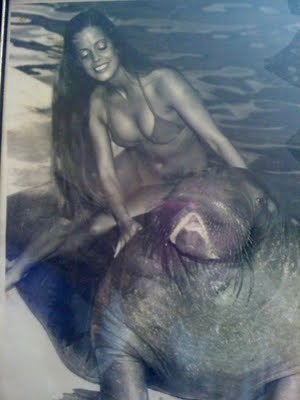 Jacque with Ozeba (?), the largest walrus at Sea World circa the superheroes show.
Jacque with Ozeba (?), the largest walrus at Sea World circa the superheroes show.
For years, this and a different but similar photo of these two were rotated in
Florida tourism ads in national magazines, newspapers, and brochures.
To quote Jacque, "Come to warm, sunny Florida to see sea animals and girls in bikinis!"
Janalee Zimmerman (Addleman): I did feel like a celebrity at the time, both at home and at Sea World. The writer of our local newspaper was just about to do an article about my skiing at Sea World when the Johnstown Flood hit. To this day it's the thing people share about me when they introduce me to someone…my kids get a kick out of it!
Jeff Parnell: Mostly just at Sea World but there was a big bar complex called Rosie O'Grady's where we were popular with the ladies.
Kaci Whittenton (Hedstrum): No, I didn't feel like a celebrity but like someone who was very lucky to have such a great job which kept you in good shape at the same time.
Kerry Lloyd: Yeah. You were. Your face was all over the airport.
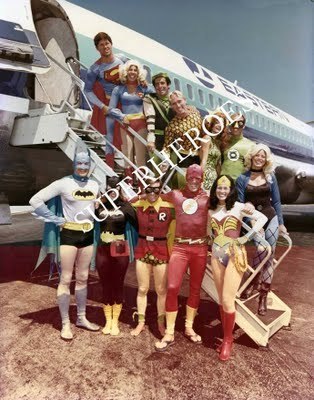 Even sandals can't slow down the Flash.
Even sandals can't slow down the Flash.
Superman—Sharkey Schwartz, Supergirl—Shirley Duke, Green Arrow—Al Valdez,
Aquaman—Mark Gutleben, Mera—Linda Lavoy, Green Lantern—Roland Hillier,
Black Canary—Randi Tetrick, Wonder Woman—Sheri McNary, Flash—Brad Whitmore,
Robin—Bill Peterson, Batgirl—Janet Rooks Shave, Batman—Randy Jones
Linda Knapp (Moffett): Not really. We punched a clock, put on our costumes, and did our jobs. It was hard work and we made it look easy. We did receive quite a few compliments on our skiing ability and we knew that people paid to see us ski. Anyone who has water skied knows how difficult some of the acts were.
Margie LaPoint (Bates): I did not feel like I carried any fame into my real life. It was a job, and a fun job to me.
Mark Gutleben: I didn't think too much of it. Made you feel proud of yourself, being an actor.
Mary McMurtrie: Big fish in a small pond. Sea World—we felt special.
Nancy Radant Combes: We were treated like celebrities in Ohio more than in Florida. Probably because of the small town feel up there.
Randy Messer: Mostly in the park. Skiers were a new group to the Sea World staff food chain, cutting in on the trainers' previously uncontested top spot. Trainers and skiers had a certain rivalry, especially when it came to the Sea Maids, which was a pool of single girls in the park.
Sherry Wickstrom: No. I did go to a dentist one time who got a kick out [it]. He said he couldn't wait to tell his kids he worked on Wonder Woman's teeth.
Shirley Duke: We felt like celebrities at the park. Going to the cafeteria, we'd take up the whole sidewalk; people would say "There go the water skiers." The guys always got bigger portions at the cafeteria. Of course the whale trainers were "the celebs."
Steve Fontaine: Yes, we all felt like celebrities at the time. We sometimes did PR appearances. I was once Superman at a Girl Scouts camp; we signed autographs and shook hands with all the girls. I was on the morning television show as Batman.
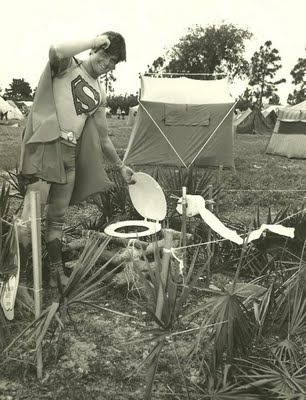 Any funny/creepy/flattering fan stories? Did you get any fan letters?
Any funny/creepy/flattering fan stories? Did you get any fan letters?
Betsy Maher (Hawkins): I do remember some young girls coming to see Greg Galloway because he looked like Donny Osmond.
Al Kelley: None as a skier but [some] when I transferred to the Animal Training Department and did the Shamu shows.
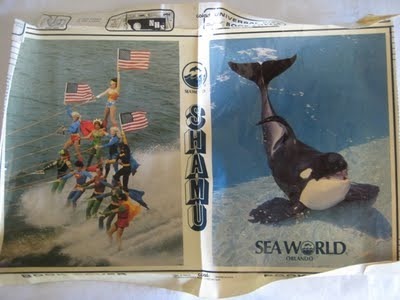 Kids could bring summer memories to school...literally,
Kids could bring summer memories to school...literally,
with this Sea World book cover.
Bill Peterson: When my son Kyle was in preschool, they had a day parents (mostly dads) could come and talk about their jobs. I talked Bubby Snow, another skier that played Batman, into going with me in costume—I was Robin. When we arrived they were running late with another person, so me and Batman had to go hang out at the IHOP for a while—in costume. That was pretty funny—lots of stares.
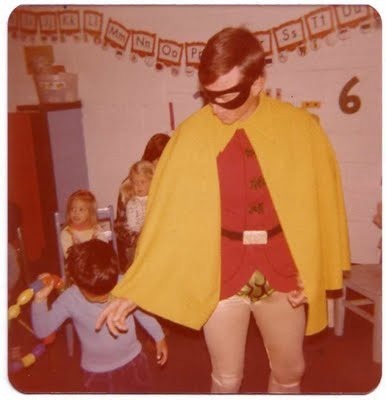 Bubby Snow: The funniest was when John Gaffey ran up on the stage as Superman and the announcer said this is the Man of Steel…but his pants [fell] down and he lost the wig. He had red hair.
Bubby Snow: The funniest was when John Gaffey ran up on the stage as Superman and the announcer said this is the Man of Steel…but his pants [fell] down and he lost the wig. He had red hair.
Greg Galloway: Myself and a couple of other skiers got flashed by a large busted girl after one of the shows (that was cool).
Janalee Zimmerman (Addleman): The funniest thing that happened to me was the first time my parents came to see the show. My dad was a great water skier and was probably my biggest fan! I was playing Lois Lane at the time and part of her role was to buy popcorn at the stand by the stadium and go sit in the audience until Jimmy the newsboy called her down out of the stand. Then she went from the stage with a camera over to the dock to film Clark Kent on skies only to end up on his back yelling and screaming as though she didn't know how she ended up there! It was funny. Okay, back to my dad and mom…as Lois, I went to buy popcorn and headed to the audience. Unbeknownst to my dad, I was dressed in a black wig, big chest, and lots of make up! Dad and I ended up in the popcorn line together and I walked up to him and said, "Hey, good lookin', where are you sitting?" He replied very uncomfortably, "With my wife." I thought he was just kidding and knew [it was] me so I teased him and followed him to his seat. Finally we sat down and he began to introduce me to my mother and I said dad it's meeee. This whole time I thought he recognized me and he hadn't! He turned as white as a ghost and then we laughed and laughed about it!
Jeff Parnell: If we saw any pretty girls in the crowd, us young guys would make an excuse after the show to go out and pick up skis or something. We would motion to the girls to come down and they always did. Those were some great times. Those days have been over for a long time.
Kaci Whittenton (Hedstrum): I got a few fan letters which made me giggle.
Nancy Radant Combes: We had our share of groupies that hung out. Some teenagers, some elderly, some kind of strange, but mostly nice. They would bring us pictures usually. One old couple sent me flowers when I had my daughter.
Sherry Wickstrom: When we came down to Orlando, they set up promotional TV spots down in Miami. Andy and I went. I did a kids' show. I knocked on a fake door and asked the host and kids if anyone has seen my invisible plane. Andy did another kids' show and the producer asked me if I would get back into costume and do the show also. I did. We were asked questions and had to ad-lib on our own.
Linda Knapp (Moffett): Some fan letters came but were addressed to a particular character, not a skier. Guys really liked the boats and would ask the boat drivers questions about them. The boat drivers, announcers, and sound personnel (and light technicians during night shows) played huge roles in the show. Even if you were the "star" of the show, you never worked alone.
Next: skiers, part 7 of 10.

Introduction to subseries "Sea World superheroes show" (including list of interviewees).
Skiers, part 5 of 10.
SWSH = Sea World superheroes
THE AUDIENCE
Did the show involve volunteers or other audience participation?
Al Kelley: Yes, we always put a child into the Batboat for a ride around the lake. [The kids] were picked out of the audience by a member of the operations team. We also brought all the heroes on to the beach at the end of the show to meet the kids.
Andy Hansen: Kids dug [the Batboat segment] big time.
Bill Peterson: My son was 18 months when I started at Sea World so he grew up thinking his father was a superhero. He begged to ride in the Batboat when he saw the other kids doing it, but you had to be three. I think the day he turned three he got to ride. The highlight of his life, at least at three.
 Bill Schwartz: Not really. But the villains did walk down the aisles [among] the audience.
Bill Schwartz: Not really. But the villains did walk down the aisles [among] the audience.Cindy Barhoff (Clasen): Lois was dressed normally and planted there.
Doby Buesse: Most kids loved [the Batboat ride]. Others cried in fear!
Kaci Whittenton (Hedstrum): I recall the warm-up act [had] an out-of-control fliver boat which would prompt audience members to help.
Randy Messer: The Batboat ride turned into a chase sequence. You had to be careful the child didn't slide off his seat.
Steve Fontaine: We would get permission from a parent to use a pre-selected child to ride in the Batboat.
Did you do more at Sea World than perform in the show, i.e. walk the park/do appearances/meet and greet?
Bubby Snow: Two characters did meet and greet after the show and were required to sign autographs. I did participate in the 1977 Tangerine Bowl as Batman. We did appearances all the time all over Orlando. Sometimes it was people in the park that just dressed up for us. Sea World employees would represent the superheroes by dressing in our costumes for some of the exhibitions as we were paid hourly and this would [spare them from paying us] time-and-a-half.
 Carl Lipsit: No, but we did do maintenance on the equipment and motors.
Carl Lipsit: No, but we did do maintenance on the equipment and motors.Diane Smith: The girl who was the full-time Wonder Woman representative at that time was not a water skier. We skiers were usually needed to perform on the water. [But] for our public relations department, I did visit places around town dressed as Wonder Woman, promoting Sea World and our show; I gave out signed Wonder Woman photos and Shamu shaped pins.
 Doby Buesse: I remember doing a PR meet and greet. Afterwards the handlers took us to Red Lobster. We forgot to bring a change of clothes. A little surreal, Batman and Wonder Woman sitting at a booth eating those garlic bread rolls.
Doby Buesse: I remember doing a PR meet and greet. Afterwards the handlers took us to Red Lobster. We forgot to bring a change of clothes. A little surreal, Batman and Wonder Woman sitting at a booth eating those garlic bread rolls. Janalee Zimmerman (Addleman): I got kissed by Shamu! We would occasionally walk in the park, but as I recall, not in costume. The skiers were definitely well-respected, though.
Janalee Zimmerman (Addleman): I got kissed by Shamu! We would occasionally walk in the park, but as I recall, not in costume. The skiers were definitely well-respected, though.Kaci Whittenton (Hedstrum): Before I became a water skier I worked as a "Sea Maid" for two summers. I swam in a tank with tropical fish, performed a underwater ballet in the pearl diving pool, and dove for pearls as well.
Shirley Duke: We did personal appearances to promote the park and the show. Usually it was Wonder Woman, Batman and Robin, or Superman. We wore special costumes for those appearances, i.e., we didn't ski in them.
Did DC Comics reps attend any shows?
Linda Knapp (Moffett): We were always told that they could show up at any time to make sure we were accurately representing each character. We did meet a few of them.
Sherry Wickstrom: They did in Ohio and discovered we had two characters that were not DC characters. They had to take them out. [NOTE: One was Tarzan.]
Did people who'd portrayed a DC Comics superhero for film or TV (i.e. Adam West who played Batman, Lynda Carter who played Wonder Woman, Christopher Reeve who played Superman, etc.) attend any shows?
Andy Hansen: They didn't tell us if they did. I am certain if Adam was there, he would have wanted my autograph. LOL.
Did other celebrities attend any shows?
Andy Hansen: The Jackson Five with parents and Donnie Osmond are a couple I think I remember.
Bubby Snow: Dolly Parton, Lou Ferrigno, Richard Simmons.
Doby Buesse: King Hussein of Jordan. He was an avid water skier.
Gary Thompson: Ronald Reagan and others.
Kaci Whittenton (Hedstrum): Bill Cosby, Tony Orlando and Dawn, and I am sure many more but don't recall.
Kerry Lloyd: Many. Kris Kristofferson and that girl he was singing with at the time. We met Bob Hope. He was way, way, way intelligent.
Linda Knapp (Moffett): Crystal Gale.
Paula Nelson (Bloemer): Yeah, I think an actor from The Bob Newhart Show worked with us one day.
Sherry Wickstrom: In the Orlando show, they would have celebrities use our stage (floating) that put on shows. They usually watched one of our shows then took a picture with all of us. [I remember] Buddy Rich.
Shirley Duke: Ruth Buzzi did a guest appearance as Lois Lane; [that time], I portrayed her on the water skiing part. She was very personable and said I had done a great job impersonating her.
Suzanne Schwartz: Sea World had a floating stage that was parked across the lake and towed over to the beach for special concerts. Any celebrities involved with those concerts hung out in the "green room," which was beneath the stadium in the same area as our locker rooms and offices. The green room was close to the main stage entrance and they could easily watch the ski show from there without having to go into the stands. Some of the celebrities I can remember performing were the Oak Ridge Boys, Barbara Mandrell, Minnie Pearl, Charlie Pride, Wayne Newton.
 Two comely skiers with comedian Marty Allen
Two comely skiers with comedian Marty AllenTHE FAME
Did you feel like celebrities at the time? If so, only at Sea World or also around town? Were you ever recognized on the street or in line at the store?
Andy Hansen: Yes, around town. Not so much as superheroes because we were not in character outside of the park. However, as Sea World skiers we were often thought of as celebs. Yes, recognized a lot.
Bill Peterson: Did not feel like a celebrity except maybe when signing autographs. After leaving Sea World in June of '79, I went on to run my own competitive water ski school for the next 25 years. I think I was recognized for that more since my picture was in a few magazines when I wrote articles on coaching and I was on TV a few times. My wife Barbara has a funny story about one time when she was shopping for the ski school food—three grocery carts full! When she wrote the ski school check, the cashier said "Wow, Bill Peterson, your husband is famous." Barbara said "Not to me."
Bill Schwartz: Yes, I did feel kind of like a celebrity. Mainly as one of the skiers. People were most impressed with the skiing tricks we did. As far as a "superhero" celebrity, our young fans thought we were the real thing and wanted our autographs.
Bubby Snow: No, we were not recognized as celebrities, but people knew we were skiers as we had Sea World haircuts which were given to us at the park. It was a short military style haircut that was very different from the '70s style.
Carl Lipsit: I think that everyone felt a bit special at the time, even though probably it was only in the confines of the park. We had clothes that were different that normal park employees, so we were identifiable. We were invited to lots of parties that the other Sea World employees hosted if they wanted to it be a bit more exciting. Ha!
Cindy Barhoff (Clasen): At times, especially when we wore our warm-ups with "Sea World Water Ski Team" on back.
Dave Madeline: At the time, Sea World had a part-time show in Ohio. In 1976 they brought the Ohio show to Florida for full-time. We would go to a bar called Draft and Cinema and see a movie for $1. The guy who owned the cinema had pictures of different Florida parks on the walls. Before the movie they would show slides of our water skiing shows. In that way we felt like celebs.
Diane Smith: I never saw myself as a celebrity (although my high school students did). I believe it was because there were others who could ski as well, or better, than I. Since we shared acts, there was no real star. One show you could be the esteemed Wonder Woman in her solo swivel, and in the next you might be Lois Lane, or a thug (though you usually were other characters as well in that same show). We would not have been recognized elsewhere because we were never introduced as ourselves.
Doby Buesse: The skiers and the animal trainers were the "glamour jobs" at Sea World. Outside of that we were just tourist attraction employees.
Gary Thompson: I suppose in the park, and we were well known around Orlando, too. Tourists who visited Sea World would recognize us outside of Sea World.
Jacque Cook (Kuntarich): No, but we did get recognized. I was constantly recognized out of costume because I was the only one with hair down to my butt. I got picked a lot as a picture girl. We were cheesecake girls. I used to do a lot of modeling for them. I laid on a walrus in a bikini. She felt like a waterbed and she was fascinated with my hair.
 Jacque with Ozeba (?), the largest walrus at Sea World circa the superheroes show.
Jacque with Ozeba (?), the largest walrus at Sea World circa the superheroes show.For years, this and a different but similar photo of these two were rotated in
Florida tourism ads in national magazines, newspapers, and brochures.
To quote Jacque, "Come to warm, sunny Florida to see sea animals and girls in bikinis!"
Janalee Zimmerman (Addleman): I did feel like a celebrity at the time, both at home and at Sea World. The writer of our local newspaper was just about to do an article about my skiing at Sea World when the Johnstown Flood hit. To this day it's the thing people share about me when they introduce me to someone…my kids get a kick out of it!
Jeff Parnell: Mostly just at Sea World but there was a big bar complex called Rosie O'Grady's where we were popular with the ladies.
Kaci Whittenton (Hedstrum): No, I didn't feel like a celebrity but like someone who was very lucky to have such a great job which kept you in good shape at the same time.
Kerry Lloyd: Yeah. You were. Your face was all over the airport.
 Even sandals can't slow down the Flash.
Even sandals can't slow down the Flash.Superman—Sharkey Schwartz, Supergirl—Shirley Duke, Green Arrow—Al Valdez,
Aquaman—Mark Gutleben, Mera—Linda Lavoy, Green Lantern—Roland Hillier,
Black Canary—Randi Tetrick, Wonder Woman—Sheri McNary, Flash—Brad Whitmore,
Robin—Bill Peterson, Batgirl—Janet Rooks Shave, Batman—Randy Jones
Linda Knapp (Moffett): Not really. We punched a clock, put on our costumes, and did our jobs. It was hard work and we made it look easy. We did receive quite a few compliments on our skiing ability and we knew that people paid to see us ski. Anyone who has water skied knows how difficult some of the acts were.
Margie LaPoint (Bates): I did not feel like I carried any fame into my real life. It was a job, and a fun job to me.
Mark Gutleben: I didn't think too much of it. Made you feel proud of yourself, being an actor.
Mary McMurtrie: Big fish in a small pond. Sea World—we felt special.
Nancy Radant Combes: We were treated like celebrities in Ohio more than in Florida. Probably because of the small town feel up there.
Randy Messer: Mostly in the park. Skiers were a new group to the Sea World staff food chain, cutting in on the trainers' previously uncontested top spot. Trainers and skiers had a certain rivalry, especially when it came to the Sea Maids, which was a pool of single girls in the park.
Sherry Wickstrom: No. I did go to a dentist one time who got a kick out [it]. He said he couldn't wait to tell his kids he worked on Wonder Woman's teeth.
Shirley Duke: We felt like celebrities at the park. Going to the cafeteria, we'd take up the whole sidewalk; people would say "There go the water skiers." The guys always got bigger portions at the cafeteria. Of course the whale trainers were "the celebs."
Steve Fontaine: Yes, we all felt like celebrities at the time. We sometimes did PR appearances. I was once Superman at a Girl Scouts camp; we signed autographs and shook hands with all the girls. I was on the morning television show as Batman.
 Any funny/creepy/flattering fan stories? Did you get any fan letters?
Any funny/creepy/flattering fan stories? Did you get any fan letters?Betsy Maher (Hawkins): I do remember some young girls coming to see Greg Galloway because he looked like Donny Osmond.
Al Kelley: None as a skier but [some] when I transferred to the Animal Training Department and did the Shamu shows.
 Kids could bring summer memories to school...literally,
Kids could bring summer memories to school...literally,with this Sea World book cover.
Bill Peterson: When my son Kyle was in preschool, they had a day parents (mostly dads) could come and talk about their jobs. I talked Bubby Snow, another skier that played Batman, into going with me in costume—I was Robin. When we arrived they were running late with another person, so me and Batman had to go hang out at the IHOP for a while—in costume. That was pretty funny—lots of stares.
 Bubby Snow: The funniest was when John Gaffey ran up on the stage as Superman and the announcer said this is the Man of Steel…but his pants [fell] down and he lost the wig. He had red hair.
Bubby Snow: The funniest was when John Gaffey ran up on the stage as Superman and the announcer said this is the Man of Steel…but his pants [fell] down and he lost the wig. He had red hair.Greg Galloway: Myself and a couple of other skiers got flashed by a large busted girl after one of the shows (that was cool).
Janalee Zimmerman (Addleman): The funniest thing that happened to me was the first time my parents came to see the show. My dad was a great water skier and was probably my biggest fan! I was playing Lois Lane at the time and part of her role was to buy popcorn at the stand by the stadium and go sit in the audience until Jimmy the newsboy called her down out of the stand. Then she went from the stage with a camera over to the dock to film Clark Kent on skies only to end up on his back yelling and screaming as though she didn't know how she ended up there! It was funny. Okay, back to my dad and mom…as Lois, I went to buy popcorn and headed to the audience. Unbeknownst to my dad, I was dressed in a black wig, big chest, and lots of make up! Dad and I ended up in the popcorn line together and I walked up to him and said, "Hey, good lookin', where are you sitting?" He replied very uncomfortably, "With my wife." I thought he was just kidding and knew [it was] me so I teased him and followed him to his seat. Finally we sat down and he began to introduce me to my mother and I said dad it's meeee. This whole time I thought he recognized me and he hadn't! He turned as white as a ghost and then we laughed and laughed about it!
Jeff Parnell: If we saw any pretty girls in the crowd, us young guys would make an excuse after the show to go out and pick up skis or something. We would motion to the girls to come down and they always did. Those were some great times. Those days have been over for a long time.
Kaci Whittenton (Hedstrum): I got a few fan letters which made me giggle.
Nancy Radant Combes: We had our share of groupies that hung out. Some teenagers, some elderly, some kind of strange, but mostly nice. They would bring us pictures usually. One old couple sent me flowers when I had my daughter.
Sherry Wickstrom: When we came down to Orlando, they set up promotional TV spots down in Miami. Andy and I went. I did a kids' show. I knocked on a fake door and asked the host and kids if anyone has seen my invisible plane. Andy did another kids' show and the producer asked me if I would get back into costume and do the show also. I did. We were asked questions and had to ad-lib on our own.
Linda Knapp (Moffett): Some fan letters came but were addressed to a particular character, not a skier. Guys really liked the boats and would ask the boat drivers questions about them. The boat drivers, announcers, and sound personnel (and light technicians during night shows) played huge roles in the show. Even if you were the "star" of the show, you never worked alone.
Next: skiers, part 7 of 10.
Published on September 07, 2011 04:56

